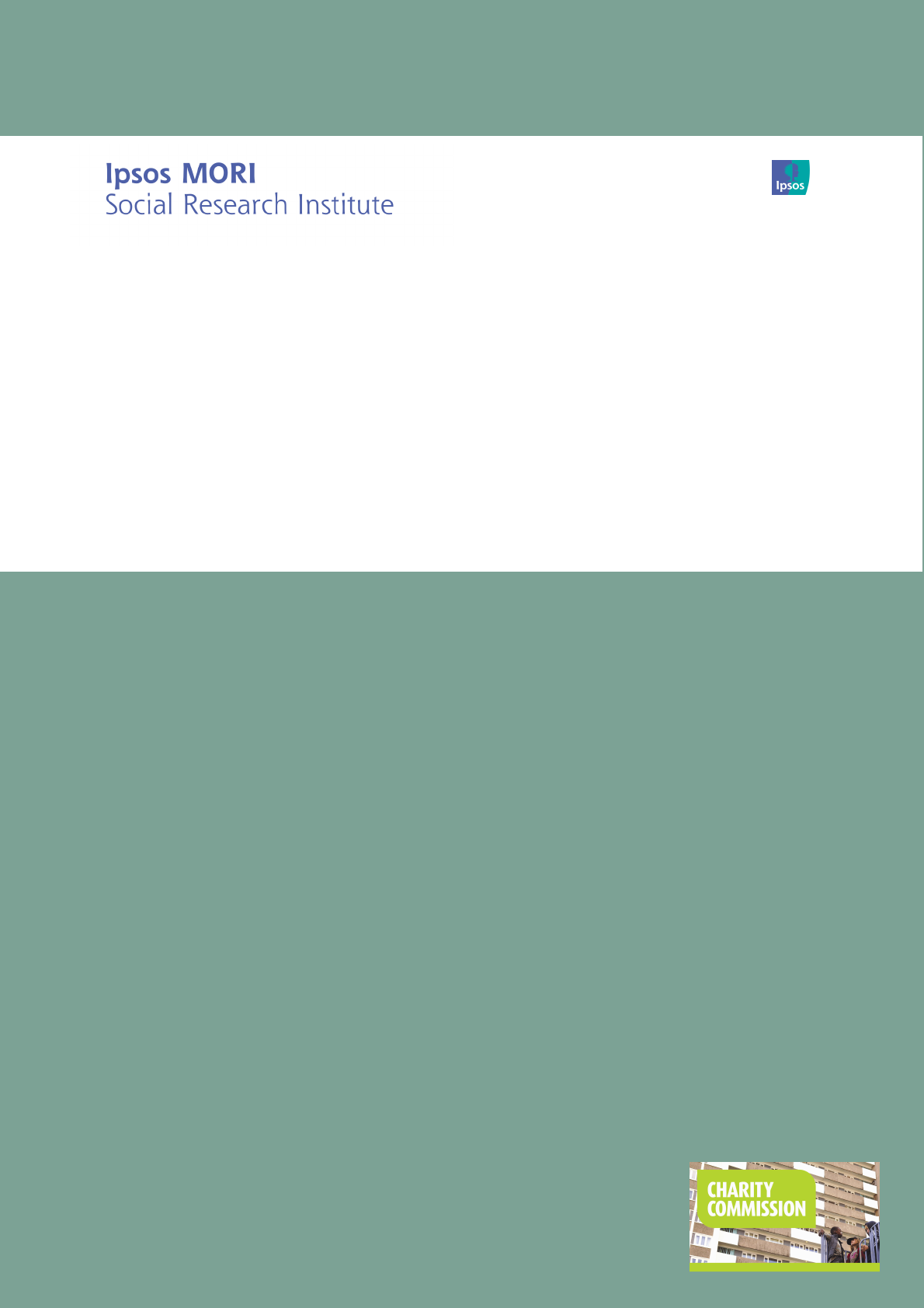
Research s
tudy conducted by Ipsos
MORI on behalf of the Charity
Commission
29 June 2012

© 2012 Ipsos MORI – all rights reserved.
The contents of this report constitute the sole and exclusive property of Ipsos MORI.
Ipsos MORI retains all right, title and interest, including without limitation copyright, in or to
any Ipsos MORI trademarks, technologies, methodologies, products, analyses, software
and know-how included or arising out of this report or used in connection with the
preparation of this report. No license under any copyright is hereby granted or implied.
The contents of this report are of a commercially sensitive and confidential nature and
intended solely for the review and consideration of the person or entity to which it is
addressed. No other use is permitted and the addressee undertakes not to disclose all or
part of this report to any third party (including but not limited, where applicable, pursuant to
the Freedom of Information Act 2000) without the prior written consent of the Company
Secretary of Ipsos MORI.

Introduction .................................................................................... 2
Methodology............................................................................................... 3
Reporting ................................................................................................... 4
Interpretation of the qualitative data ........................................................... 4
Executive Summary ....................................................................... 6
Introduction ................................................................................................ 6
Factors relating to trust .............................................................................. 8
Trust and confidence in charities and other organisations ...... 12
Overall trust and confidence in charities .................................................. 13
Trust in specific aspects of charities’ performance ................................... 15
Understanding the feelings behind trust in charities ................................. 18
Reasons for trusting specific charities more or less ................................. 20
Importance of transparency and reporting ............................................... 23
Impact of size and familiarity on trust in charities ..................................... 25
Reported change in trust and confidence in charities ............................... 28
Perceptions of charities’ conduct .............................................................. 31
Fundraising and spending ........................................................................ 34
Charities’ importance in society ................................................................ 36
Trust in charities to provide public services .............................. 39
Types of service ....................................................................................... 39
Specific aspects of service provision ........................................................ 41
Public awareness and understanding of the Charity Commission 44
Awareness and familiarity ........................................................................ 44
Understanding the issue of regulation ...................................................... 47
Charity beneficiaries and active involvement ............................ 48
Charity beneficiaries ................................................................................. 48
Active public involvement with charities ................................................... 50
Key drivers of trust and confidence in charities ........................ 52
Appendices ................................................................................... 61
Guide to statistical reliability ..................................................................... 61
Topline findings ........................................................................................ 62
This report presents the findings of the 2012 Charity Commission study into public trust and
confidence in charities, conducted by Ipsos MORI on behalf of the Commission.
The study was first conducted by the Charity Commission in 2005, in response to the Draft
Charities Bill (now the Charities Act 2006), which proposed a new statutory objective for the
Charity Commission to increase public trust and confidence in charities. The study was
repeated in 2008 and 2010 to track progress towards this aim. This wave of research again
monitors progress on this measure as well as other key questions.
The main objectives of the 2012 research are to:
• Investigate public trust, confidence and general attitudes towards charities in 2012
(and change since 2005, 2008 and 2010 where applicable), including:
o overall trust and confidence in charities;
o trust in specific aspects of charities’ performance;
o factors affecting trust in charities;
o general perceptions of charities;
o trust in charities to provide public services;
o awareness and understanding of the Charity Commission’s role; and
o level of involvement with, and benefit from, charities.
• Explore the key drivers for overall trust, updating the key driver findings from the 2010
research.
• Explore variations in results by age, gender, region, socio-economic group and other
key demographic characteristics.
• Compare the results for trust in charities against other areas of society e.g. doctors,
police, key public institutions, and politicians.
Methodology
Quantitative Methodology
A representative survey of 1,142 adults aged 18+ in England and Wales was conducted
by telephone. Interviewing was conducted between 4 and 21 May 2012.
Telephone leads were generated at random, using Random Digit Dialling (RDD).
Quotas were set on the following demographic variables to ensure the final sample was
representative of the adult population of England and Wales:
1. gender;
2. age;
3. socio-economic group;
4. working status;
5. region; and
6. ethnicity.
The sample size was ‘boosted’ to at least 100 respondents in regions which otherwise would
have contained fewer than 100 respondents (in a representative sample), to allow reliable
analysis by region. Down-weighting was then used to ensure that the final sample remained
representative of the overall population. Weighting was also used to correct for minor
differences between the final sample profile and the population profile.
Qualitative Methodology
In addition to the quantitative survey, ten in-depth interviews were conducted over the
telephone from 28 May to 1 June 2012. This was to allow us to explore some of the issues in
greater depth and to add context and understanding to the quantitative data.
As part of the survey, participants were asked whether they would mind being re-contacted
to take part in further research on this project. Those who were happy to be re-contacted
formed the sample for the recruitment for the qualitative depth interviews.
Loose quotas were set, based on responses to particular survey questions, including:
• trust in charities: five with higher trust (6-10); five with lower trust (0-5) (Q1);
• level of familiarity with the Charity Commission: at least two who know the
Charity Commission fairly/very well; at least two who know the Charity Commission
not very/not at all well (Q13B).
Participants were recruited using Ipsos MORI’s in-house qualitative recruitment specialists.
Reporting
The results reported and presented graphically in this report are based on the 1,142
representative interviews with adults 18+ across England and Wales, unless otherwise
stated.
Figures quoted in graphs and tables are percentages. The size of the sample base from
which the percentage is derived is indicated. Note that the base may vary – the percentage is
not always based on the total sample. Caution is advised when comparing responses
between small sample sizes.
As a rough guide, please note that the percentage figures for the various sub-samples or
groups generally need to differ by a certain number of percentage points for the difference to
be statistically significant. This number will depend on the size of the sub-group sample and
the percentage finding itself, as noted in the appendices.
Where an asterisk (*) appears it indicates a percentage of less than one, but greater than
zero. Where percentages do not add up to 100% this can be due to a variety of factors –
such as the exclusion of ‘Don’t know’ or ‘Other’ responses, multiple responses or computer
rounding the decimal points up or down. Computer rounding may also lead to a one
percentage point difference in combination figures (such as total agree or disagree) between
those in the text and in the charts.
Interpretation of the qualitative data
While qualitative research was an integral part of this study, it is important to bear in mind
that qualitative research is based on very small samples, and is designed to be illustrative
rather than to produce statistics. This should be taken into account when interpreting the
research findings. It is also important to bear in mind that the research deals with perceptions
rather than facts (though perceptions are facts to those that hold them).
Throughout this report, the qualitative findings are clearly differentiated from the quantitative
findings using coloured boxes. We have made use of verbatim comments to expand upon
and provide further insight into the quantitative findings. However, it is important to be aware
that these views do not necessarily represent the views of all participants.


Ipsos MORI has been tracking public trust and confidence in charities on behalf of the
Charity Commission since 2005. The specific focus of this trend research is the
Commission’s statutory objective to increase public trust and confidence in charities, and the
survey also collects valuable data on wider public perceptions of charities amongst adults
living in England and Wales.
In May 2012 a representative survey of 1,142 adults aged 18+ in England and Wales was
conducted by telephone. Additionally, 10 follow-up qualitative interviews were conducted in
May and June 2012.
Introduction
This research is conducted at an interesting time for the charitable sector, with austerity
measures arguably placing greater pressure on charities to fill the gaps left in public service
provision accompanied by increasing challenges to the funding environment.
The NCVO UK 2012 Civil Society Almanac
1
estimates that by 2015/16 the voluntary sector is
likely to lose £1.2bn in government income each year. The Almanac identifies that: the sector
receives £13.9bn from government, 79% of which is contracts for services; charity spending
increased in real terms by £1.1bn in 2008-10 as charities expanded their services in order to
meet increased demand; and public sector grants fell by almost £500m during the initial
recession dip. Free reserves were £42.2bn in 2009/10 which is £4.1bn lower than at the
beginning of the decade in real terms.
The government’s Giving White Paper 2011 recognises the valuable role that charities play
in society today and sets out the government’s agenda for, “Making it easier and more
compelling for people to give time and money and so make the change they want to see.”
2
In
addition to introducing new incentives and a range of motivational measures aimed at
encouraging social norms around giving, the government looks at ways in which easier
modes of giving might be facilitated, such as giving by Automatic Teller Machine (ATM) or
Round Pound schemes to give small amounts when paying by card. However, the latest
Citizenship data (2009-10)
3
indicates a slight downward trend in charitable giving, placing
greater pressure on fundraisers at this time of government spending cuts.
1
http://data.ncvo-vol.org.uk/
2
http://www.official-documents.gov.uk/document/cm80/8084/8084.pdf
3
http://www.communities.gov.uk/documents/statistics/pdf/2056233.pdf Methods of giving: Door-to-door collection
street collection; sponsorship; collection at church, mosque or other place of worship; shop counter collection; pub
collection; collection at work; buying raffle tickets (not national lottery); buying goods from a charity shop or
catalogue; direct debit, standing order, covenant or debit from salary; giving to people begging on the street; other
method of giving.
!
Indeed, these are two key patterns seen in the 2012 Public Trust and Confidence data:
• There has been an increase in the proportion of adults who agree that some
fundraising methods used by charities make them uncomfortable. This is
accompanied by evident concerns amongst the public that charities spend too much
on salaries and administration, which is held up as a key barrier towards greater
charitable giving. This points to clear challenges for fundraisers and for charities to
overcome the public’s (arguably often unrealistic) expectations of the proportion of
their donations that reach the end cause.
• The survey also supports the view that charity spending is increasing to meet
demand, with a rising perception that charities play an essential role in society (those
saying charities play an essential role has risen from 30% in 2010 to 37% in 2012).
There has also been an increase in the proportion of the public who use a range of
different charities’ services.
The Key Drivers Analysis offers an interesting context for these findings. When asked to
directly select which one quality is most important to their trust and confidence in charities
overall, the greatest proportion of the public (43%) prioritise ensure a reasonable proportion
of donations make it to the end cause. However, in the Key Drivers Analysis, ensuring
charities make a positive difference to the cause they are working for comes through as the
strongest driver of overall trust in charities, while ensuring a reasonable proportion of
donations make it to the end cause ranks lower down. This indicates that while respondents
may state the importance of donations reaching the end cause, it is actually the impact that
charities have that is the strongest driver of their overall trust levels (which is supported by
the sub-group analysis of the survey data).
This shows an interesting contrast in perceptions of the sector – negative media stories
about wastage have a hugely negative impact on the sector as a whole, which is possibly
leading to people citing donations reaching the end cause as a more top of mind issue that
drives trust in charities. However, positive levels of trust are actually more likely to be driven
by user experience and the good work that charities do.
The Charity Commission has a clear role to play in offering the public reassurance that
negative stories about charities are the exception rather the norm, wider publicising of their
regulatory role, and supporting the sector in the celebration of positive user experiences. The
research also indicates the need for a review of fundraising methods, which is part of a
current review of the Charities Act 2006 by Lord Hodgson.

"
Overall trust and confidence in charities
Public trust and confidence in charities remains high, with the mean score for trust being in
line with previous years at 6.7. Charities are still one of the most trusted groups, with only the
police and doctors being more highly trusted
4
.
Three quarters of the public (73%) give a rating of six out of ten or higher for trust and
confidence, which shows a significant increase in those using the upper end of the scale over
the last four years, rising from 68% of people in 2008. Between 2005 and 2012 there has
also been a decrease in people stating trust levels towards the bottom of the scale (10% give
a rating of 0-4 compared to 14% in 2005).
However, when prompted with a direct question on how trust and confidence has changed in
the past two years, while three quarters of the public say it has stayed the same, the
proportion saying it has decreased in the last two years has risen from 11% in 2010 to 16%
in 2012. Conversely, the proportion saying it has increased remains consistent with 2010.
Media coverage and negative stories about how donations are wasted are the most
frequently given reasons provided for a decrease in trust over the past two years. The
volume of charities and direct material received from charities is also cited.
Looking at trust and confidence overall, the message remains a positive one and charities
are highly trusted. However, negative media coverage of the way that charities spend money
is clearly having a negative impact on trust for some people.
Factors relating to trust
The most important factor relating to trust remains ensuring a reasonable proportion of
donations make it to the end cause, with more than four in ten choosing this option (43%).
This is followed by making a positive difference to the cause they work for, with three in ten
seeing this as most important (31%). The public do generally trust charities to ensure money
reaches the end. However, as previously mentioned, negative media stories have negatively
impacted on this perception amongst some.
Qualitative research was undertaken with ten survey respondents to look at their views on
trust and confidence in more detail. How money is spent was a key issue for these
individuals, with concerns raised about salaries for charity staff, spending on fundraising, and
charity reserves. There was also some concern over being able to see where money had
gone when charities are sending funds overseas.
Transparency and reporting is important in overcoming some of the concerns about how
money is spent and the impact charities have. The overwhelming majority of people believe
charities should provide the public with information on how they spend their money (96%)
and on how they benefit the public (94%). This was a very important theme in the qualitative
research, where participants strongly felt that charities had to show how they spent money
and what impact it had to encourage more people to support them.
4
This reflects the findings of Ipsos MORI’s veracity index, which we have been tracking since 1983:
http://www.ipsos-mori.com/researchpublications/researcharchive/2818/Doctors-are-most-trusted-
profession-politicians-least-trusted.aspx
#
The public tend to agree that they trust charities more if they have heard of them (82%),
highlighting the importance of familiarity. In the qualitative research this issue was seen by
some as a barrier for smaller charities who may not have the high profile or ability to
publicise themselves as some of the bigger ones. However, there was also some scepticism
amongst these participants about larger charities and whether they spend their funds
appropriately.
As well as familiarity, a local presence is also important, with three in five people agreeing
they trust charities more if they are providing services within their local community (59%).
Public perceptions of charities’ conduct are strong, with three quarters agreeing charities are
trustworthy and act in the public interest (74%). The qualitative research reveals that the
public have positive views about the motivations of charities, seeing them as trying to benefit
society and support people.
Where the public have concerns these are around fundraising techniques and the use of
funds. Fundraising methods are of increasing concern among the public, two thirds (67%) of
the public agree that some fundraising methods used by charities make them uncomfortable,
which is a significant increase from the proportion who said this in 2010 (60%). Almost three
in five (59%) believe charities spend too much on salaries and administration.
The societal role of charities, charity beneficiaries and involvement
The public continue to place high importance on the role that charities play in society (96%
say charities play an essential, very important or fairly important role, which is consistent with
2010). However, given the current economic climate it is particularly interesting that the
proportion saying charities play an essential role has significantly increased from 30% in
2010 to 37% in 2012.
This is accompanied by an increase in the proportion of people who have used a charity's
services – a third of people (34%) now say they have benefited from or used the services of
a charity, or had close friends or family do so, compared to 30% in 2010. Compared to 2010
there has also been an increase in the proportion of respondents (by at least three
percentage points or more) saying they, or any of their close friends or family, have done
each of the following: used the services of a charity; received advice from a charity;
telephoned a charity’s information or helpline; received emotional support or counselling from
a charity; been a patient in a local hospice; received personal care from charity workers; and
received financial help from a charity.
That this increased use of charitable services is accompanied by an increase in the
proportion of the public who feel charities play an essential role in society today indicates a
growing reliance on the charitable sector. It is worrying that the data also point to increasing
frustration and even rejection of fundraising methods in the sector, which in the context of
decreasing government spending creates clear challenges for the sector.
Over a third of people (37%) say they, or a close friend or family member, are actively
involved in a charity as an employee, volunteer or trustee. Those who are actively involved in
a charity have higher levels of overall trust in charities then those who do not, which is
consistent with those who have greater familiarity with a particular charity having higher level
of trust. This highlights the positive impact of direct experience.
$%
Charities and public service provision
Public authorities are still thought to be best at providing services including care homes,
social housing, leisure or sports centres, hospitals, schools and information/advice services.
However, an increasing proportion feel that charities would be best at providing information
and advice, 20% compared to 16% in 2010. Compared to 2010 the proportion of people who
have personally or whose close friends or family has received advice from a charity has
increased by six percentage points to 37% in 2012. In the qualitative research service
provision was not something that had been considered strongly, but there was a sense
amongst participants that charities could provide a more personal, caring service. This is also
seen in the quantitative findings, where most think charities are best at providing a caring
approach (47%).
Awareness and perceived importance of the Charity Commission
Awareness of the Charity Commission has not changed significantly since 2010, with just
over half of the public being aware of it (55%, compared to 53% in 2010). Once explained,
people’s appreciation of the Commission’s role is very high, with 98% believing its role is
essential, very or fairly important – 91% say they personally think it is essential or very
important compared to 87% in 2010).
Regulation was seen as being important by those taking part in the qualitative research.
They felt it was important for charities to be held to account on how their funds were spent.
Since this tracking survey began in 2005 we have seen an increasing use of charitable
services and the rising perception that charities play an essential role in society today. The
public perceives that charities operate to ethical aims and operate for the public good, but at
the same time demand accountability and that a large proportion of donations reach the end
cause. While members of the public are unlikely to check a charity's accounts themselves, or
necessarily seek to reassure themselves that their money is being spent wisely, exposure to
negative media stories creates doubt that this may not be the case and can have a damaging
effect on the sector as a whole.
Given the increasingly important role that charities play in society, the Charity Commission's
role is becoming ever more important.

$
© 2012 Ipsos MORI.
&'

12
Key Findings
Overall trust and confidence in charities in 2012 remains consistent with 2010, with
a mean score of 6.7 compared to 6.6 in 2010.
Charities remain one of the most highly trusted organisations included in the
questionnaire, third only after doctors and the police.
Adults in England and Wales are still confident in general that charities make a
positive difference to the cause they work for, with a mean score of 7.2. However,
the public is less confident about charities’ ability to ensure a reasonable
proportion of donations make it to the end cause (mean 6.1), with just 28% stating
high trust (8-10) despite more than four in ten (43%) saying this is the most
important quality for trust in charities. This is also a quality which is frequently
mentioned by respondents in the qualitative interviews.
The most common reason why some charities are trusted less is not knowing how
their money is spent (36% who trust certain charities less than others mention
this). People interviewed qualitatively felt they wanted to know where money went
and were concerned that staff and administration costs were too high.
Having seen/experienced what they do was the main reason given by people who
mentioned trusting some charities more than others (38%).
An overwhelming majority of people (96%) agree that charities should provide the
public with information on how they spend their money, with a similarly high
proportion agreeing that charities should demonstrate how they benefit the public
(94%). This is a strong theme in the qualitative interviews, with many saying they
would like charities to do more to publicise the breakdown of where fundraising
revenues are allocated.
Familiarity with charities has a strong bearing on trust, with more than eight in ten
(82%) trusting charities more if they have heard of them. Size is less important,
with the public split on whether they trust big charities more than small ones.
(
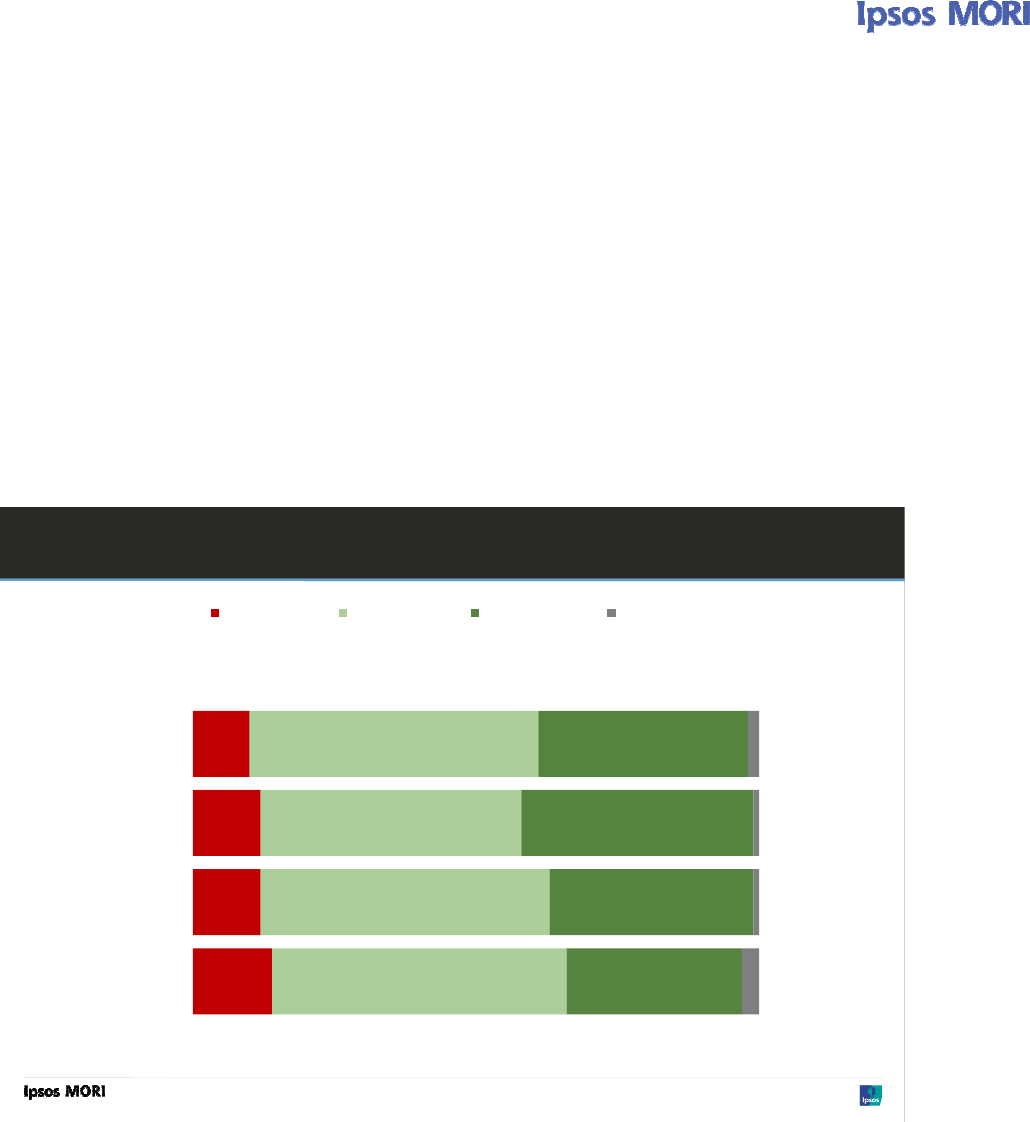
13
Overall trust and confidence in charities
The public were asked to give an overall trust and confidence rating in charities using a scale of 0
to 10, where 0 means they do not trust charities at all, and 10 means they trust charities
completely.
Almost three quarters of respondents (73%) now give an overall rating of six out of ten or above,
up on both 2010 and 2008 (70% and 68% respectively). This is a significant increase in trust from
2008 levels. As a result the mean score increases very slightly to 6.7 (as shown in the following
chart, although note that this is not a statistically significant increase), however the general
distribution of trust and confidence across the scale has remained similar.
Q – Firstly, thinking about how much trust and confidence you have in charities overall, on a scale of 0-10 where 10
means you trust them completely and 0 means you don’t trust them at all, how much trust and confidence do you have
in charities?
© Ipsos MORI
10
12
12
14
51
46
51
52
37
41
36
31
2
1
1
3
2012
2010
2008
2005
0-4 5-7 8-10 Don't know
Trust and confidence in charities
Mean
6.3
6.7
6.6
Base: Adults aged 18+ in England and Wales – 2012 (1,142); 2010 (1,150); 2008 (1,008), and 2005 (1,001)
0 = Don’t
trust them
at all
10 = Trust
them
completely
6.6
Source: Ipsos MORI
Direct experience of a charity has a positive influence on levels of trust and confidence – people
who have benefited from a charity give a mean score of 7.0 compared to a score of 6.5 from those
who have not. The same is true for those who work for a charity, who also give a mean score of
7.0, compared to 6.5 for those who do not work for a charity.
People living in the South East are significantly less likely to give a high rating of 9 or 10 than
people in most of the other regions, although the South East mean of 6.5 is not significantly lower
than the average of 6.7. In fact, it is people living in London who offer a significantly lower mean
score than average of 6.4, which is also significantly lower than the two highest scoring regions –
the North East (7.1) and the South West (7.0) (although these scores are not significantly different
to any of the other regions).
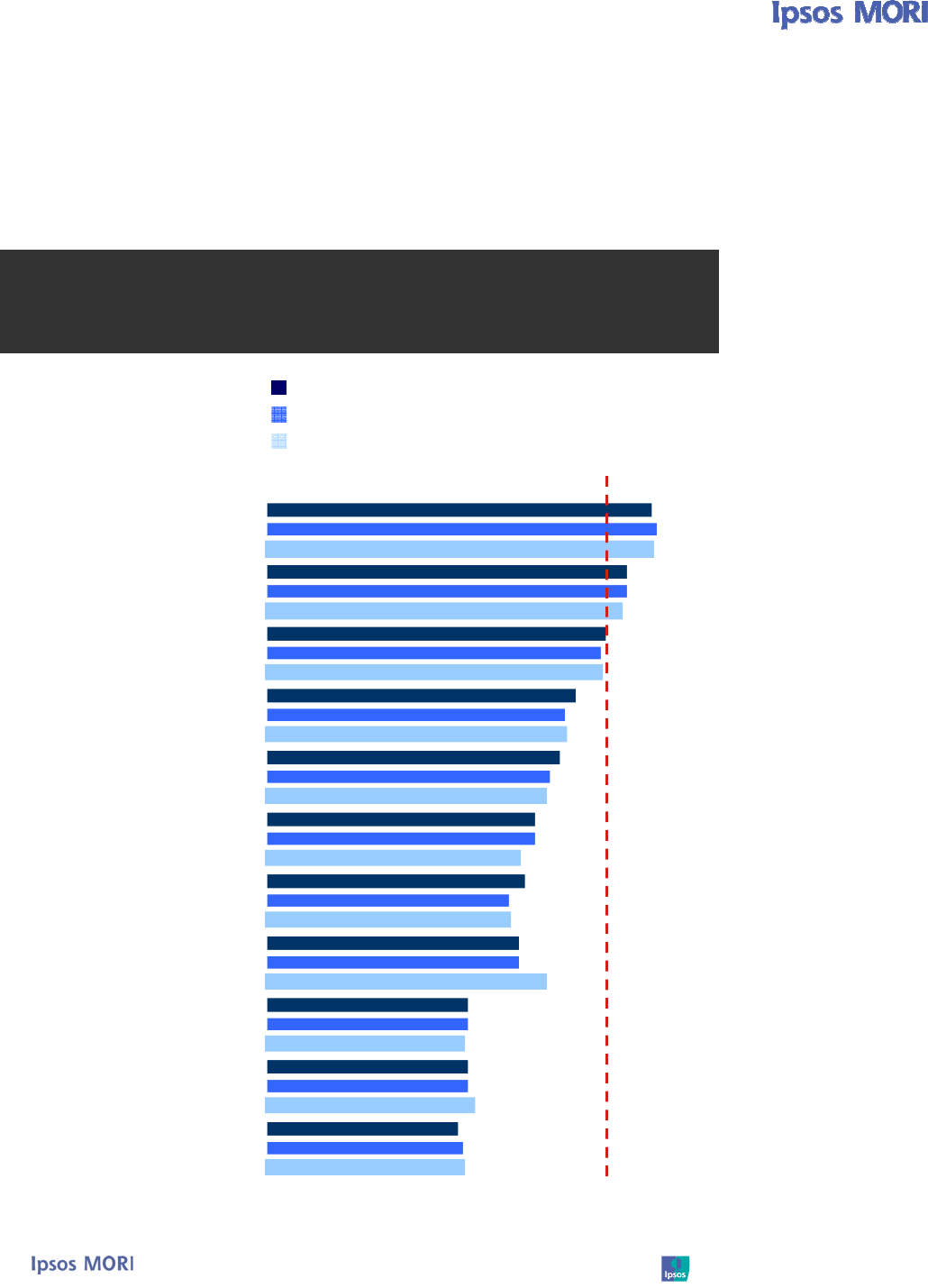
14
Comparison with other organisations
As seen in previous waves of this survey, the public have a higher level of trust and confidence in
charities than most other organisations included in the questionnaire. Again, doctors and the police
are the two exceptions. Mean scores have moved very little over the past two waves of research
as shown in the chart below:
Q – Now for some other types of organisations and professions. On a scale of 1-10 where 10 means you trust them
completely and 0 means you don’t trust them at all, please tell me how much trust and confidence you have in
…
7.6
7.1
6.7
6.1
5.8
5.3
5.1
5.0
4.0
4.0
3.8
7.7
7.1
6.6
5.9
5.6
5.3
4.8
5.0
4.0
4.0
3.9
7.6
7.0
6.6
5.9
5.5
5.5
5.0
4.8
3.9
4.1
3.9
Public trust and confidence in charities
vs. other organisations
Base: Adults aged 18+ in England and Wales – 2012 (1,142); 2010 (1,150); 2008 (1,008)
Doctors
Police
Charities
Social Services
Ordinary man / woman
in the street
Banks
Private companies
Your local Council
MPs
Government Ministers
Newspapers
Source: Ipsos MORI
2010 Mean Scores
2008 Mean Scores
2012 Mean Scores

15
Trust in specific aspects of charities’ performance
When asked about some more specific aspects of trust in charities, again there are mixed results
with regard to how charities are perceived in certain areas. The following chart illustrates this point.
Q – And on the same 0-10 scale, how much would you trust charities to…
Public trust in charities to . . .
7.2
6.7
6.7
6.6
6.1
6.7
7.1
6.8
6.7
6.6
6.2
6.6
7.0
6.7
6.4
6
6.6
7.2
6.5
6.2
5.9
6.3
Make a positive
difference to cause
they are working for
Ensure fundraisers
are honest and
ethical
Be well managed
Ensure
reasonable
proportion of
donations get to
end cause
% high trust
(8-10)
*Make independent
decisions, to further
the cause they work
for
49
Overall trust
42
35
29
42
38
30
24
45
34
28
24
41
36
31
N/A
N/A
2012 Mean Score
2008 Mean Score
2005 Mean Score
2010 Mean Score
Base: Adults aged 18+ in England and Wales – 2012 (1,142); 2010 (1,150); 2008 (1,008), and 2005 (1,001)
28
52
39
39
32
37
37
Source: Ipsos MORI* New in 2010
With a mean score of 7.2, there are high levels of trust in charities to make a positive difference to
the cause they are working for, which is in line with the 7.1 mean score in 2010. Many also feel
that they trust charities to ensure that its fundraisers are ethical and honest with a mean score of
6.7. While people do feel charities will ensure that its fundraisers are ethical, two thirds feel
uncomfortable about some of the fundraising methods used (67%). Perceptions around
fundraising are explored in more detail later in this report. Ensuring that a reasonable proportion of
donations make it to the end cause is an area the public perhaps feel less confident about, with a
mean score of 6.1.

16
Women’s trust in charities is significantly higher than men’s, both at an overall level and for
specific aspects of charities’ work, reflecting a similar pattern to 2010, with women giving a mean
score of 6.9 compared to 6.5 for men. As seen in previous years, younger people tend to have a
greater level of trust and confidence in charities, with a mean score among 18-34 year olds of 7.0,
higher than any other age group. Around four in ten (39%) 18-34 year olds rate their overall trust
and confidence in charities at 8-10 which is less than 35-44 year olds (43%) despite their
significantly lower mean score of 6.6. This is due to 18-34 year olds being more clustered around
the middle scores, while a greater proportion of people in the 35-44 (and 45-54) age group are
more likely to give a score of four or less.
In line with their greater mean score for overall trust, people living in the North East had the
highest mean score on the majority of these measures.
Interestingly, those who believe that it is most important for charities to ensure that a reasonable
proportion of donations make it to the end cause are significantly less positive about their trust and
confidence in charities than those who believe it is most important for charities to make a positive
difference to the cause they work for, with a mean score of 6.6 compared to 7.1.
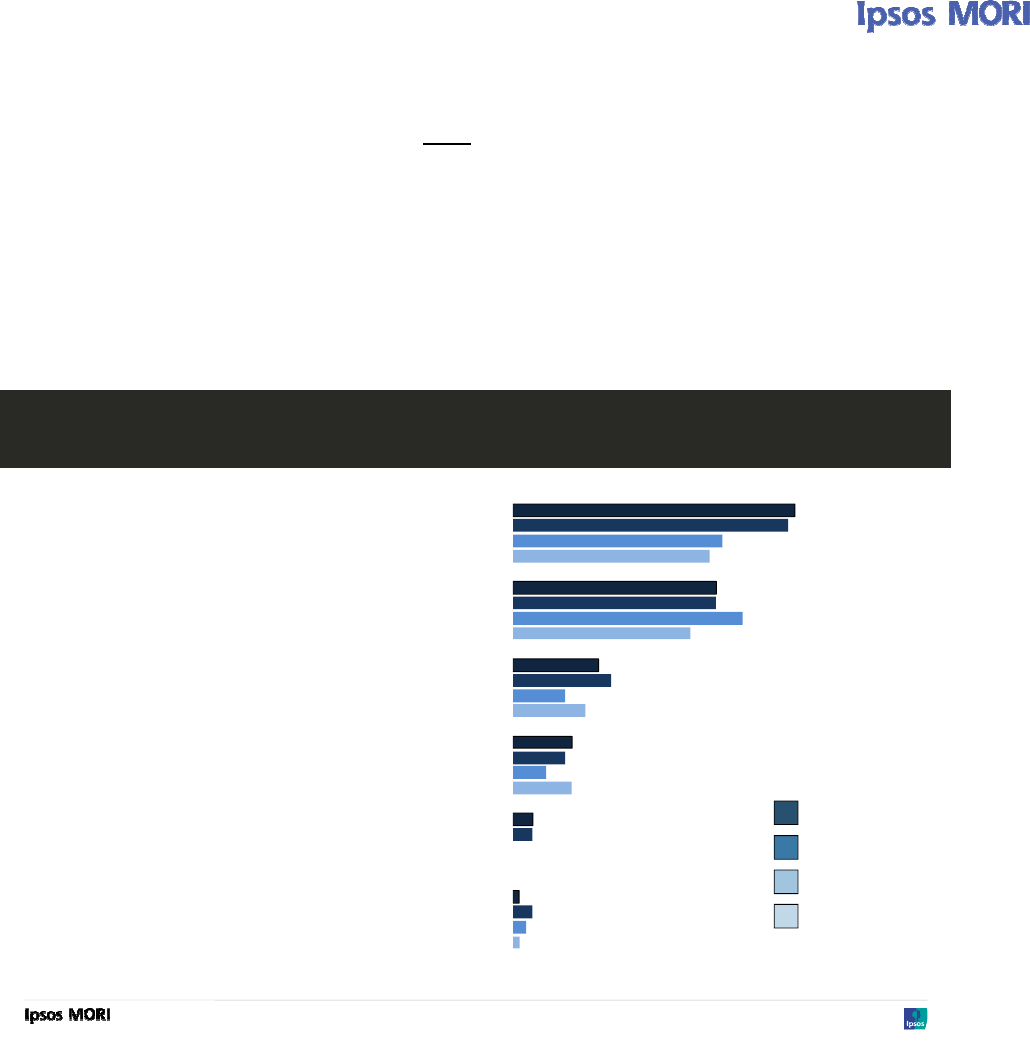
17
Most important quality for trust in charities
As in 2010, the public still believe that ensuring that a reasonable proportion of donations make it
to the end cause is the quality they think is most important to their trust and confidence in charities
overall (43%).
Making a positive difference to the cause they work for (31%) is the next most frequently
mentioned quality. In 2010, we saw a shift from the public seeing this issue as most important to
ensuring a good proportion of donations reach the end cause and this has remained consistent in
2012. As suggested last year, this could well be a symptom of the economic climate and a desire
to see charities follow suit in this respect. It is also apparent that negative media stories can
challenge the public’s assumption that charities are spending money responsibly.
Q – Which one, if any, of these qualities is most important to your trust and confidence in charities overall?
© Ipsos MORI
Most important qualities for trust and confidence
43%
31%
13%
9%
3%
1%
42%
31%
15%
8%
3%
3%
32%
35%
8%
5%
2%
30%
27%
11%
9%
1%
Ensure reasonable proportion of donations get
to end cause
Make a positive difference to cause they
work for
Ensure fundraisers are honest and ethical
Be well managed
Make independent decisions to further the
cause they work for
Don’t know
Base: All respondents – 2012 (1,142), 2010 (1,150), 2008 (1,008), 2005 (1,001)
Source: Ipsos MORI
2010
2008
2005
2012

18
It is interesting to note that overall trust and confidence in charities appears to be related to views
on which of these qualities is most important. As the table below shows, the less trust people have
in charities, the more likely they are to feel that ensuring donations get to the end cause is most
important, and the less likely they feel that making a positive difference is most important. This
underpins the view that how charities spend their funds is of key importance to levels of trust and
confidence.
Overall trust and confidence in charities (Q1)
0-4
(n=109)
5-7
(n=581)
8-10
(n=433)
Ensure that a reasonable
proportion of donations make it
to the end cause
48% 45% 40%
Make a positive difference to the
cause they are working for
18% 28% 38%
Looking at regional differences, people living in the South East (52%) are significantly more likely
than average (43%) to select ensure reasonable proportion of donations make it to end cause.
People living in the East Midlands (39%) are significantly more likely than average (31%) to select
make a positive difference for cause they’re working for (the same proportion as those who select
ensure reasonable proportion of donations make it to end cause in the East Midlands).
Understanding the feelings behind trust in charities
As in 2010, ten qualitative depth interviews were conducted to dig a little deeper into feelings
behind trust and confidence in charities and explore particular issues in more detail. When asked
about initial impressions of charities and what they do, there are many consistent themes which
arise regardless of trust in charities: charities are expected to raise money for a specific cause; to
work to help both those in need and to benefit wider society in general; and to act independently
and efficiently. There is a sense that in current economic circumstances charities are often doing
the work that public bodies cannot or will not do.
“I think [charities] provide an absolutely vital role, almost to the point of some of the things that the
government can’t do because of finances, charities step in and do.”
Male, high trust in charities, familiar with the Charity Commission (Int 10)
Trust in charities was not something many participants had thought about in any real depth prior to
the research. However, when prompted, some of those who gave a low trust score at the
quantitative phase were able to cite particular examples where they felt charities hadn’t operated
as effectively or honestly as they should have done, which may go some way to explaining their
low trust score. In some cases this was due to discovering how money was being spent. It should
be noted that the quantitative findings show that 56% of people agree they know very little about
how charities are run, and it is often the case that people have unrealistic expectations about how
much of their donation should reach the end cause.
“I used to think [charity] was amazing… but when it came to light that actually, most of the money
that you would give them would go on administration fees and salaries for the people working for
the charity… I stopped giving.”
Male, low trust in charities, not familiar with the Charity Commission (Int 3)

19
There was some concern amongst participants about how international charities used their money.
One participant in the qualitative interviews explained that she actually had quite high trust for
charities operating in the UK, but had given a low score because she had low confidence in
charities operating abroad due to not being convinced money reached the intended recipients.
This was not because she believed there was any wrongdoing on the part of the charity, but
because she thought that the potential for the money to end up with the ‘wrong’ people was higher
overseas.
There is an overwhelming sense that supporting charity is a question of personal preference, and
that people will give to and trust charities based largely on their personal experiences and feelings.
As the next section discusses, this is very much something which comes through in the
quantitative phase, with a wide variety of charities selected by respondents when asked if there
are certain charities/charity types they trust more or less.
“I don’t think anybody appreciates it until you’re personally involved with it… It’s opened our eyes.
It’s raised a lot of awareness with us and it does make you realise how much they need help and
funding.”
Female, low trust in charities, not familiar with the Charity Commission (Int 5)
There was a general feeling amongst some participants that the motivations of charities were
good, and this fostered trust. Charities and their employees were felt to be acting for the general
good, rather than personal gain.
“Charities are doing some good. They may not be doing the sort of good I’d want them to do but I
think there’s a sort of mission statement within all charities that I find attractive.”
Male, high trust in charities, familiar with the Charity Commission (Int 8)
The importance of ensuring that a reasonable proportion of donations reach the end cause came
through very strongly in the quantitative phase, so it is no surprise that this was also frequently
mentioned by respondents in the depth interviews. There is a perception, particularly among those
with lower trust in charities, that too much money may be spent on administration or salaries of
charity employees, and so it is important to be selective with regard to which charities people
support and to be able to see donations producing something tangible.
“I personally do subscribe to a charity but it’s a charity which is close to home. I can see what they
spend their money on – it’s equipment, very expensive equipment. It’s in the UK [too], so I can see
how it’s being spent and I can see the result of that money.”
Male, low trust in charities, not familiar with the Charity Commission (Int 7)
“The money goes to the [individual] and you can see this person is receiving this amount of
money; it’s helping them in whatever way. You can see the outcome.”
Male, low trust in charities, not familiar with the Charity Commission (Int 3)
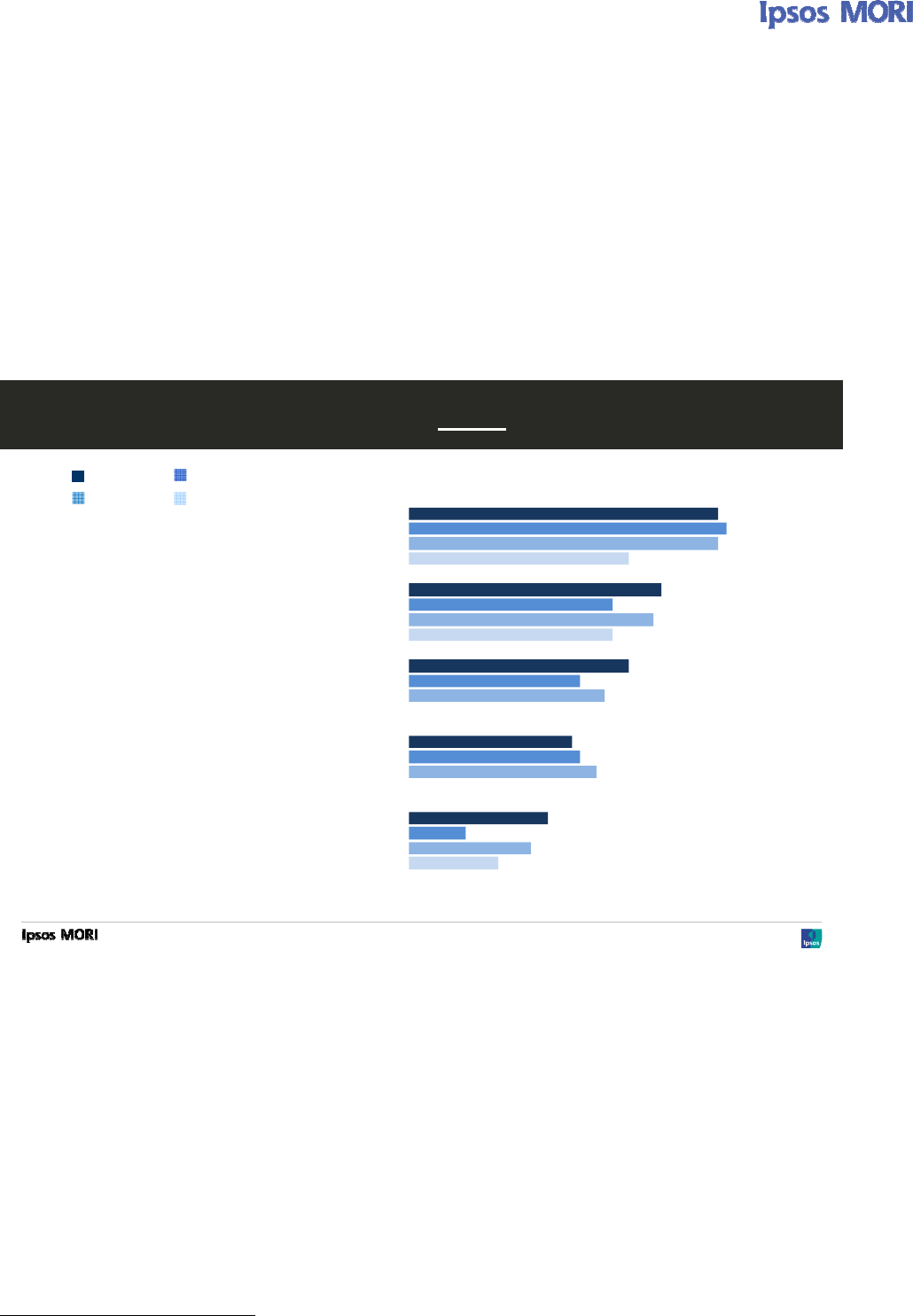
20
Reasons for trusting specific charities more or less
Two thirds of the public (64%) can name a specific charity or type of charity that they trust more
than others. As seen in previous waves of this survey the specific charities or charity types which
are mentioned vary widely, suggesting that this is very much a personal consideration. As in 2010,
charities which are mentioned most frequently tend to be larger charities with a national presence
in the United Kingdom, namely Cancer Research UK (12%), Oxfam (6%), the British Heart
Foundation (5%) and British Red Cross (5%).
5
Reflecting this, the most common reasons given for higher trust include contact or familiarity with a
charity, such as having seen or experienced what they do (38%); because they believe in the
cause/what they’re trying to do (31%); because they have a good reputation (27%); and because
they are well known (20%), as shown in the chart below:
Q – Why do you say that? Why do you trust xxx more than others?
© Ipsos MORI
38%
31%
27%
20%
17%
39%
25%
21%
21%
7%
38%
30%
24%
23%
15%
27%
25%
11%
Reasons for trusting a charity more than others
Because I have seen/experienced what they do
Because they do an important job
Because I believe in the cause/what they are
trying to do
*Because they are well-known
*Because they have a good reputation
Top five mentions only
Base: All respondents mentioning a charity/charity type – 2012 (745); 2010 (702); 2008 (678); 2005 (725).
*Response options were grouped in 2005 but separated out in the 2008 and 2010 studies. 2005 result for this grouped code was 30%.
Source: Ipsos MORI
2012
2008
2005
2010
Conversely, 43% of the public name a charity or type of charity which they trust less than others.
Oxfam (3%) is the most mentioned specific charity type and the only one mentioned by more than
1%, perhaps reflecting their status as a well-known charity. Again, 5% of respondents feel that
they trust international charities less than others. Recent research conducted by Ipsos MORI with
people giving donations to international charities revealed that understanding where the money
goes is of crucial importance to them in deciding to give.
As in 2008, the most frequently cited reasons for not trusting particular charities or types of
charities include: not knowing how they spend their money (36%); hearing ‘bad stories’ about them
(21%); dislike of fundraising techniques used (14%) and a perception of money being lost through
corruption or not getting to the end cause (11%), as the chart below shows:
Please refer to the topline in the appendices for full table of figures relating to this question.
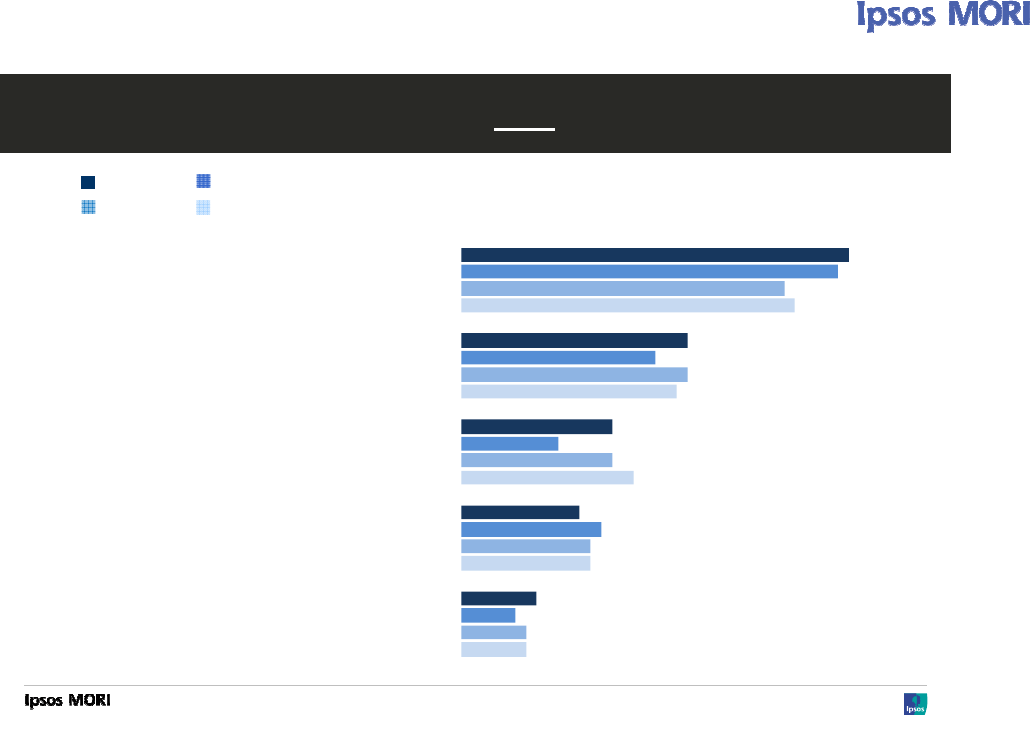
21
Q – Why do you say that? Why do you trust xxx less than others?
© Ipsos MORI
Reasons for trusting a charity less than others
Because I don’t know how they spend their money
Because I have heard bad stories about them
Because they are big
Money lost through corruption/open to abuse/
doesn’t get to end cause
Because they are international
Base: Respondents mentioning a charity/charity type – 2012 (62); 2010 (409); 2008 (419); 2005 (214)
36%
21%
14%
11%
7%
35%
18%
9%
13%
5%
30%
21%
14%
12%
6%
31%
20%
16%
12%
6%
2012
2008
2005
2010
Top five mentions only
Source: Ipsos MORI
Those in social class DE are significantly more likely to say that personal experience is a
particularly important reason why they trust some charities more than others: 45% of those who
trust a charity or charity type more than others say this compared with 38% overall.

22
Those interviewed qualitatively gave a variety of reasons why they trust a charity or type of charity
more or less than others, but there are some consistent themes coming through their responses.
Familiarity and size are two crucial aspects with regard to trust in charities, and these are covered
in detail in a separate section later in this report. However, another theme which consistently
comes up among respondents is charities using what many regard as undesirable fundraising
methods.
Volume is one aspect of this: people complain of being ‘bombarded’ with leaflets and other
material which encourages them to donate to a specific cause. In one instance, a charity given a
one-off donation continued to ask for money on numerous occasions over many years following
the donation.
However, another aspect of fundraising methods perceived negatively is the way in which certain
techniques have been adopted by charities to encourage donations. Charities that go door-to-door
asking for donations are perceived in a negative light because people are felt put upon to donate
on the spot, and there is a sense in which many want to be left alone to make their own choice
about which charity to donate to. Also, use of emotive imagery showing people in distress is seen
by some as a very cynical way of encouraging people to donate. Previous research on charity
messages conducted by Ipsos MORI revealed that negative messages and images were less
favoured by potential donors. They preferred to see a positive image that demonstrated the good
their donation could do.
“They put these poor children [on charity advertising]. No doubt children do have to suffer bad
things like that, but it makes me feel guilty... but how many can you afford to send to?”
Female, low trust in charities, not familiar with the Charity Commission (Int 1)
Telephone fundraising, ‘chuggers’ and those who carry collection tins are also a source of
frustration. Research conducted on ways of giving in April 2012 found that putting money into a
collection tin was the preferred way of giving, so the issue may be more about the way people are
approached rather than the method itself, as those in the qualitative research were discussing
people being ‘pushy’.
There is particular concern about how much revenue is spent by charities on administration and
salaries, and on publicity and marketing for the charity. This is heavily tied to the earlier point
about ensuring that money reaches the end cause, but for many, the fear that their donations
might be spent on advertising or on salaries discourages them from donating. The size of reserves
charities hold was a real concern for one participant. As mentioned earlier, it should be considered
whether the public have unrealistic expectations of how much it costs to run a charity and if
isolated negative media stories are having a disproportionate impact on views.
“When you don’t know a great deal [about charities] and you hear what’s on the news… paying
their boards high salaries and this sort of thing, your trust in these charities becomes less and
less.”
Male, low trust in charities, not familiar with the Charity Commission (Int 7)
“When there is a rotten egg, it gets splashed all over the press… blackening the whole sector from
something that’s been given a lot of prominence [in the media].”
Female, high trust in charities, familiar with the Charity Commission (Int 2)
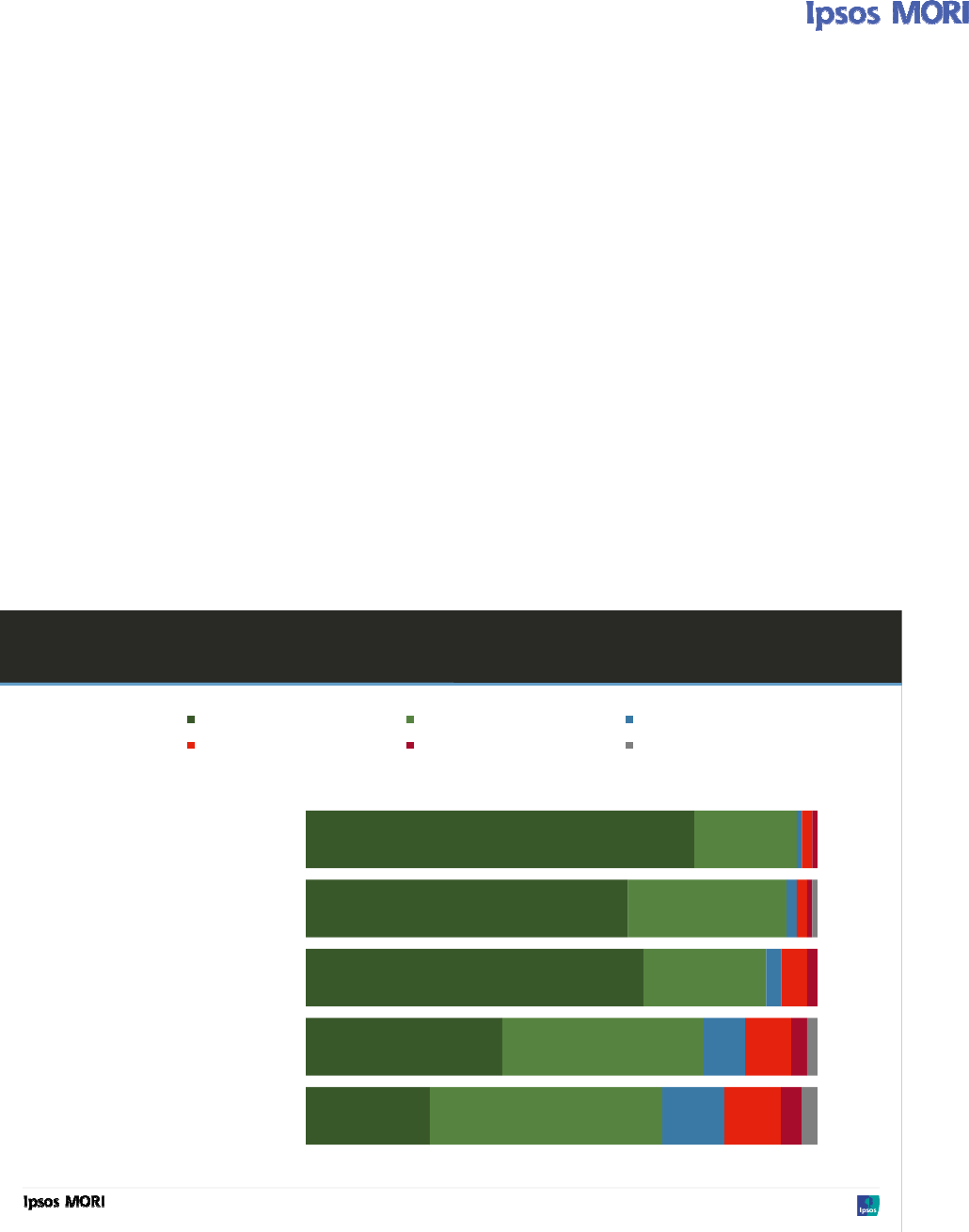
23
Importance of transparency and reporting
There is little doubt that once more the overwhelming majority of the public feel charities should
provide the public with information on how they spend their money – 96% agree in 2012, the same
proportion in 2010 and 2008. Three quarters (76%) agree strongly, in line with figures from 2010
(73%). Nine in ten (89%) people whose confidence in charities has decreased over the past two
years agree strongly that charities should provide the public with more information on how money
is spent, significantly more than average. This raises the question of whether more information
would improve trust, as well as how this information should be provided.
There is also widespread agreement that charities should demonstrate how they benefit the public
(94%), but as last year a smaller proportion strongly agrees (63%) compared to those who strongly
agree that charities should provide information to the public on how money is spent (76%).
While the public do want information on how money is spent, the form in which they want this
information in is less clear. Publishing an annual report explaining what they have achieved is
considered to be slightly less important than actually demonstrating their benefit – 89% agree (as
did 90% in 2008) and 66% agree strongly. This highlights one of the big challenges in meeting the
public’s needs – the qualitative research highlights that people are unlikely to actively seek this
information and there is a sense of being bombarded by too much information from charities,
which makes it difficult to achieve cut-through of key messages.
Q – Thinking about charities in general, to what extent do you agree or disagree with each of the following statements.
Is that strongly or tend to agree/disagree?
© Ipsos MORI
76
63
66
38
24
20
31
24
39
45
1
2
3
8
12
2
2
5
9
11
1
1
2
3
4
1
2
3
% Strongly agree % Tend to agree % Neither / nor
% Tend to disagree % Strongly disagree % Don't know
Transparency and reporting
Base: 1,142 adults aged 18+ in England and Wales. 4
th
– 21
st
May 2012
It is crucial that charities demonstrate
how they benefit the public
It is important to me that charities
explain in a published annual report
what they have actually achieved
Agree
%
96
89
It is important to me that charities
provide the public with information
about how they spend their money
77
94
70
Charities provide society with
something unique
Charities are effective at bringing
about social change
Source: Ipsos MORI

24
It was noted in 2010 that transparency and reporting were not top-of-mind during the qualitative
interviews, with a greater focus on the good work charities do. While the good work charities do
was prominent amongst those qualitatively interviewed, there was also a strong focus on the need
for transparency and knowing how charities make a difference and spend their money.
Many state explicitly that they would like to see charities do more to publicise their fundraising
activities and to give a more detailed breakdown of where their money goes. It seems that many
are unaware of how they can find out this information should they want to, and there is a sense
that charities are scrutinised much less than other bodies because of their status as charities.
“Where can I go where I can actually see how the money that is given to the particular charity is
spent? Every so often you may get a publicity stunt where they show you a few photographs on a
billboard or something like that. That isn’t good enough these days.”
Male, low trust in charities, not familiar with the Charity Commission (Int 7)
“They are generating money every year as charitable income. We just assume because it’s a
charity that they are spending it efficiently.”
Male, high trust in charities, familiar with the Charity Commission (Int 4)
On the other hand, charities have to be careful with their money because of the risk that if they are
seen to be profligate with donations, people will be discouraged from giving to them and they will
suffer as a result.
“They’re aware that actually, if we do waste money it will come out and people won’t give us any
more money.”
Male, low trust in charities, not familiar with the Charity Commission (Int 3)
While those who are less trusting of charities tend to be more sceptical about them and the degree
to which they are transparent about their funding and administration, those who are more trusting
of charities and who have more experience or knowledge of how they work do know about the
work charities have to do to publish information.
“I was aware that there was a process, and that each year things had to be submitted and our
reports had to be put out.”
Female, high trust in charities, familiar with the Charity Commission (Int 6)
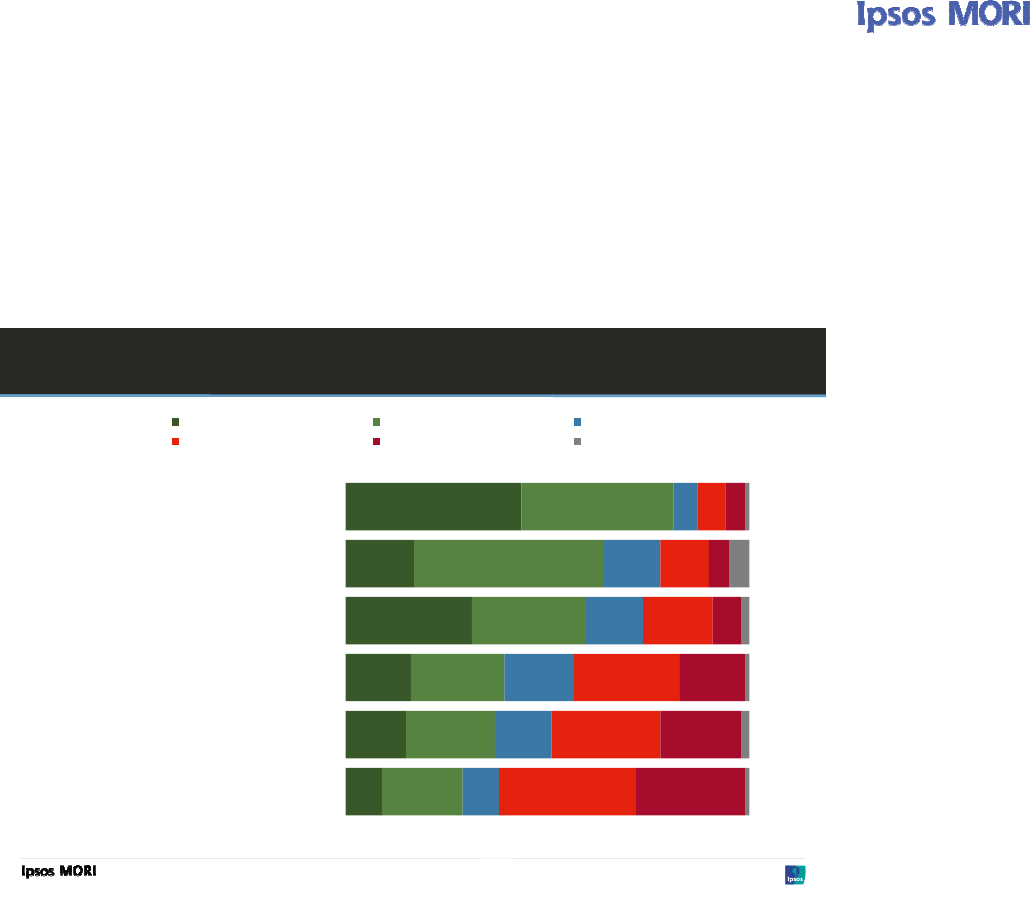
25
Impact of size and familiarity on trust in charities
As one might expect, more than eight in ten (82%) agree that they place greater trust in charities
that they have heard of, similar to the 83% who said this in 2010. As in 2010, two in five (40%)
trust charities more if they have a well-known patron, though it is interesting to note that around
the same proportion (43%) do not agree that having a well-known patron has any bearing on their
trust in a charity. The data are shown in the chart below:
Q – I’m now going to read out a list of statements and ask you how much you agree or disagree with each of them…
© Ipsos MORI
44
17
31
16
15
9
38
47
28
23
22
20
6
14
14
17
14
9
7
12
17
26
27
34
5
5
7
16
20
27
1
5
2
1
2
1
% Strongly agree % Tend to agree % Neither / nor
% Tend to disagree % Strongly disagree % Don't know
82
Agree
%
63
59
40
37
29
Public trust and attitudes towards charities
I trust charities more if I have heard of them
Base: 1,142 adults aged 18+ in England and Wales, 4
th
– 21
st
May 2012.
I trust charities to work independently
I trust charities more if they are providing
services within my local community
I trust charities more if they have well-known
people as patrons
I trust big charities more than smaller ones
I feel confident donating to a charity even if I
haven’t heard of them, if it’s going to a good
cause
Source: Ipsos MORI
The majority of the public are inclined to trust local charities, with three in five (59%) agreeing that
they trust charities more if they are providing services within their local community. Interestingly,
those in lower social classes are significantly more inclined to agree here than others – 67% and
65% of those in social classes C2 and DE, respectively, agree compared with 54% of those in AB
or C1.
Almost half of the public (47%) disagree that they trust big charities more than smaller ones,
continuing the trend seen in previous waves that appears to suggest that size is much less
important to the public than familiarity. It was observed in 2010 that younger people (18-34) are
more inclined than the public in general to trust big charities more than smaller ones. This
relationship remains in 2012 with almost half (47%), of young people agreeing compared to 37%
overall.
While three quarters (74%) of people living in London still tend to agree that I trust charities more if
I have heard of them, this is significantly lower than the average of 82%. Similarly, providing
services in a local community is a little less important with half (49%) of people in London agreeing
that I trust charities more if they provide services in my local community compared to the overall
average of 59%. Whilst not significantly different to the overall mean, it might be noted that people
living in London give the lowest mean rating for overall trust in charities (6.4, which is significantly
lower than the region with the highest mean - the North East with 7.1). People in London are also
less likely than average to say they, their friends or close family have benefited from or used the
services of a charity.
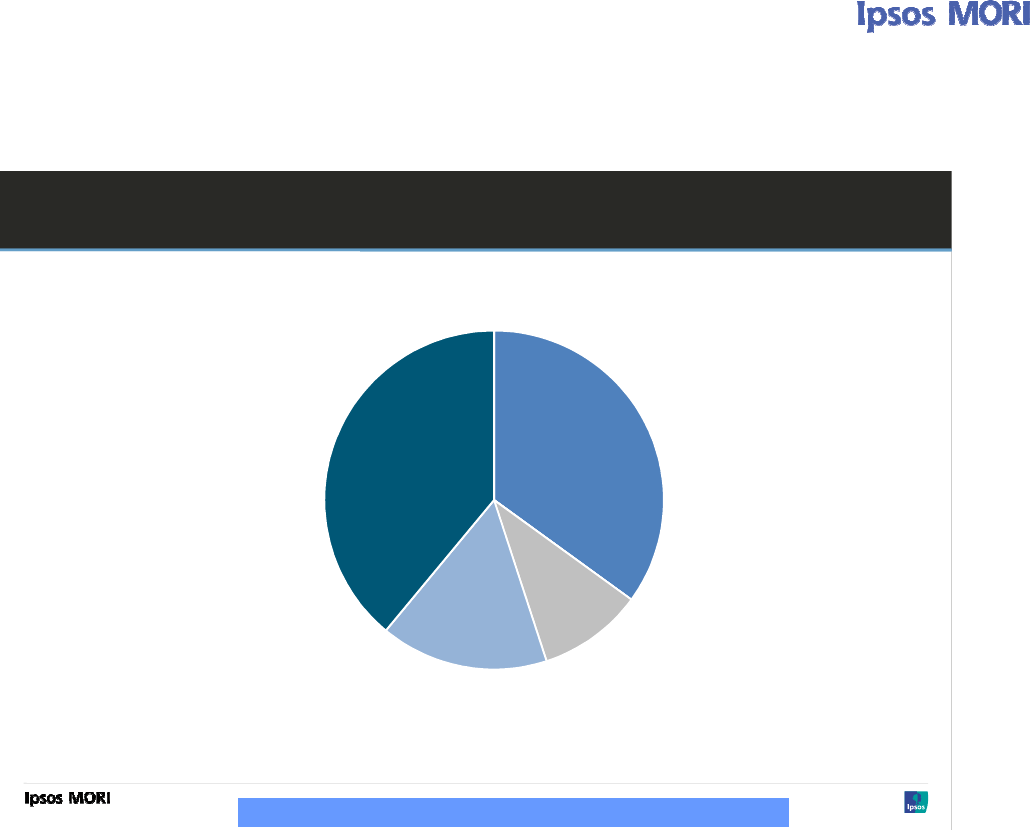
26
These results broadly correspond to findings in a survey we conducted on behalf of Zurich
Insurance in 2011 which suggested that the British public are just as likely to support smaller local
charities as they are large, well-known charities, as demonstrated in the chart below.
Q – Which of these statements comes closest to your views on donating to charity?
© Ipsos MORI
35%
10%
16%
39%
Views on donating to charity
I prefer to donate to
large well known
charities with a good
reputation
I prefer to donate to smaller
charities or voluntary groups
who are working in my local
community
I do not give to
charity
Base: 1,003 British adults aged 15+, 25 Feb – 3 Mar 2011
Don’t know
Research conducted by Ipsos MORI on behalf of Zurich Insurance
Source: Ipsos MORI

27
The quantitative results suggest that there is no clear consensus regarding trust in bigger or
smaller charities, and this rings true in the qualitative interviews too, as it did in 2010. Some
identify benefits of larger charities as being able to fulfil roles which governments leave empty in a
way that smaller charities cannot.
“[Small charities] provide a useful forum, but because they have not got the skills that perhaps can
be obtained in the larger charities, and by that I mean training and listening skills like that,
sometimes they can do a bit of harm… I think there’s far too many small charities.”
Male, high trust in charities, familiar with the Charity Commission (Int 10)
The perception that larger charities are not spending funds appropriately is apparent amongst
some participants. Concern over the salaries of staff, money spent on administration, size of
reserves and money spent on fundraising are all mentioned.
“I think what I would call the more generic charities, people are less comfortable with. I think it
tends to be the big national generics that have the chuggers. They seem to be now in business to
raise funds to be spent as executive fees. It’s inappropriate… If you have a big national charity,
there’s no reason why you can’t organise that on a local basis, so perhaps a dozen local
organisations who are more accountable then to local people.”
Female, high trust in charities, familiar with the Charity Commission (Int 2)
I do wonder about the big charities. Does all that money go [to the end cause], or is a lot of that
eaten up in administration?
Female, low trust in charities, not familiar with the Charity Commission (Int 1)
There is a national/international dimension here too, particularly with regards to being able to
observe money going to an end cause. While acknowledging that international charities do an
important job and do benefit society, there is a sense in which it is difficult to see where the money
goes when donating to large international charities.
“I’m more for [giving to charities in] this country than abroad because I don’t feel that I know where
that money’s going. I know where they say it’s going, but you don’t know that it gets there.”
Female, low trust in charities, not familiar with the Charity Commission (Int 5)
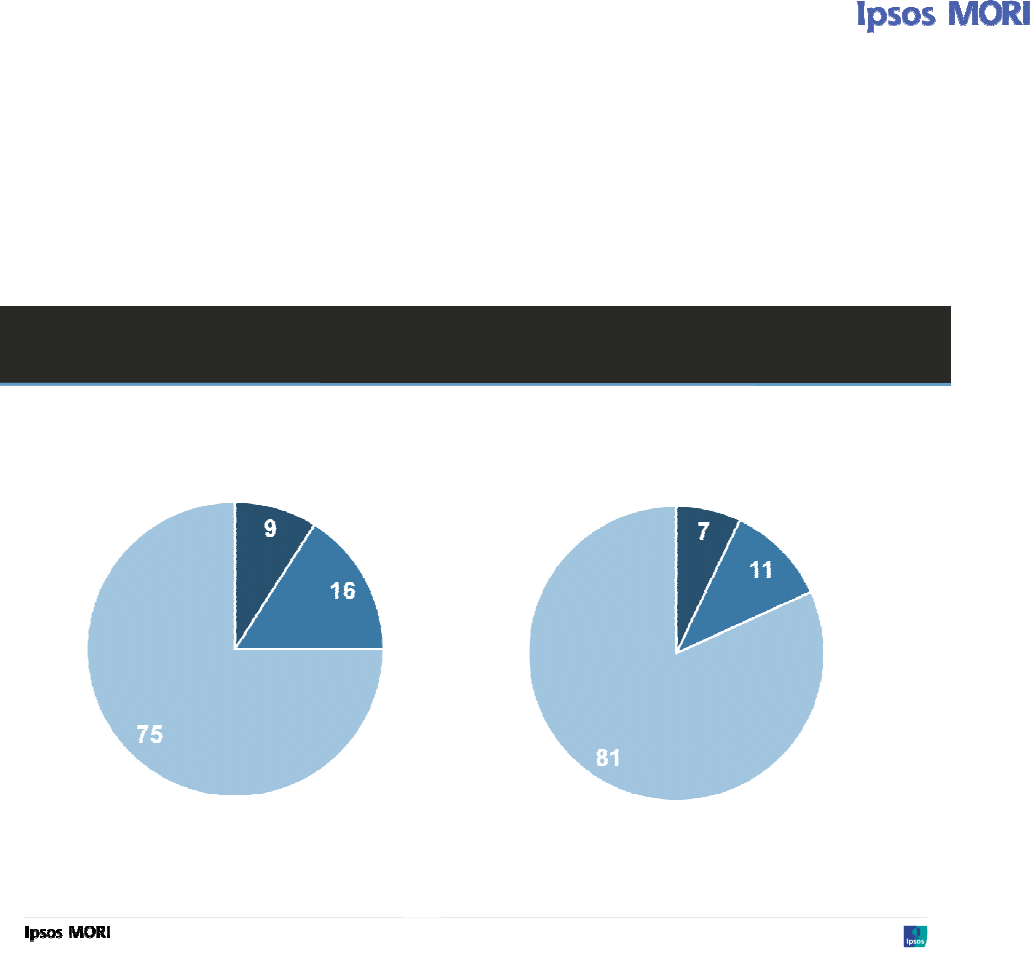
28
Reported change in trust and confidence in charities
The public’s views on trust and confidence in charities have changed over the last two years.
While 81% stated that their trust in charities had stayed the same over the past two years prior to
2010, this has dropped to three quarters in 2012 (75%). Consequently, a greater proportion of the
public are inclined to say their confidence has either increased (9%, up from 7% in 2010, although
this is not statistically significant) or decreased (16%, up from 11% in 2010). The reasons behind
this are explored in the following section.
Q – Over the past two years, has your trust and confidence in charities increased, decreased or stayed the same?
© Ipsos MORI
Change in trust and confidence in charities
%
Decreased
% Stayed the
same
% Increased
%
Decreased
% Stayed the
same
% Increased
Base: Adults aged 18+ in England and Wales – 2012 (1,142); 2010 (1,150)
2012 2010
A greater proportion of younger people (18-34) say their trust in charities has increased over the
past two years: 16% say this in 2012 (significantly more than the 9% overall). Conversely, over a
quarter (26%) of 55-64 year olds say their trust in charities has decreased, which is also
significantly more than average.
The majority of the small group of the public who say their trust has increased in the past two
years cite direct experience of the charity’s services themselves (38%) or through someone they
know (13%) as the reason why, media stories about charities in general (17%) and volunteering
for a charity (15%) are also mentioned.

29
Q – Why do you think your trust and confidence in charities has increased? And has anything else influenced this
change?
© Ipsos MORI
38%
17%
15%
13%
8%
7%
7%
6%
4%
2%
2%
Reasons for increase in trust and confidence
Top mentions only (2% or above)
Base: All respondents who said their trust in charities has decreased in the past two years (96 – caution, small base)
Using/experiencing a charity’s services directly
Media stories about a charity (generally)
Know more about them e.g. staff, different charities
Media coverage about how charities spend donations
Doing a good job/what they’re supposed to
Began volunteering/working for a charity
Someone I know using/experiencing a charity’s services
Lots of charities now
They need donations/finding it hard to obtain money
Increase in need due to wars/natural disasters/poverty/hunger
Political pressure
Source: Ipsos MORI
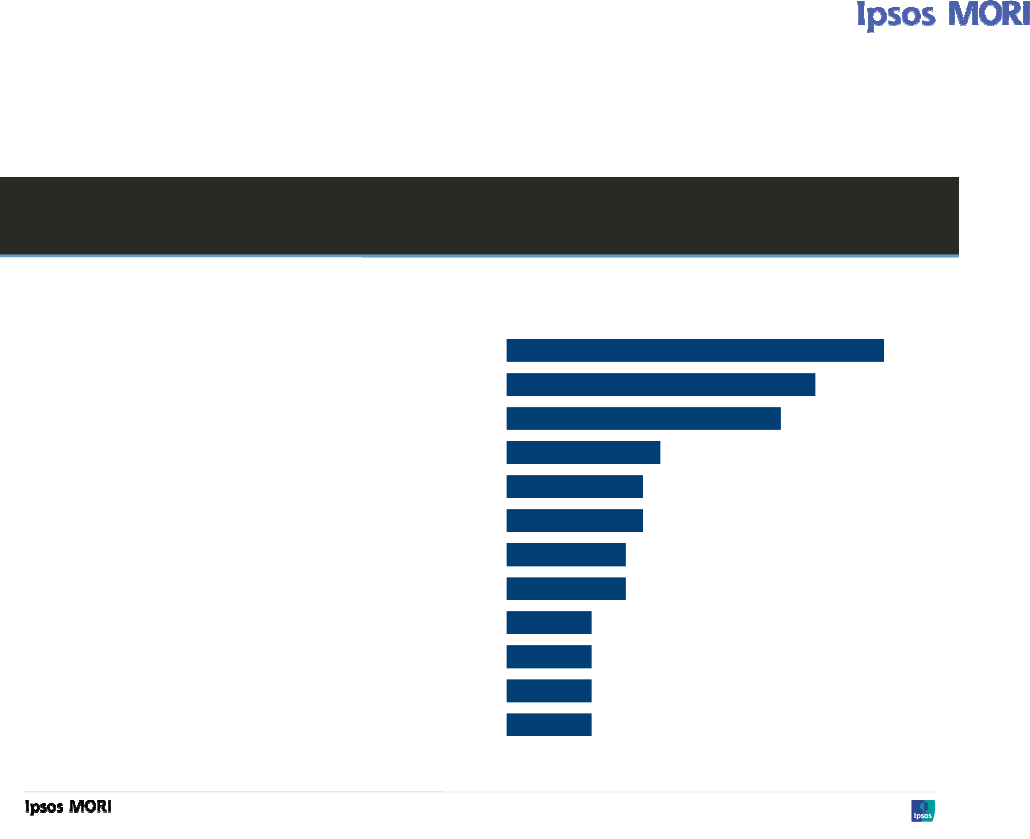
30
Conversely, negative media coverage about charity spending (22%) and charities in general (18%)
are the main reasons cited by those who say their trust in charities has fallen.
Q – Why do you think your trust and confidence in charities has decreased? And has anything else influenced this
change?
© Ipsos MORI
22%
18%
16%
9%
8%
8%
7%
7%
5%
5%
5%
5%
Reasons for decrease in trust and confidence
Top mentions only
Base: All respondents who said their trust in charities has decreased in the past two years (179)
Media coverage about how charities spend donations
(expense claims, bonuses etc)
Media stories about a charity/charities (generally)
The expenses scandal (generally)
They use pressuring techniques/I receive a lot of post from charities
Someone I know using/experiencing a charity’s services
Don’t trust them/I distrust/don’t know where the money
goes/waste a lot of money
Too many of them now
Using/experiencing a charity’s services directly
Political bias/pressure
They are being treated as a business/profit making
Began volunteering or working for a charity
You never see the benefits/don’t think they make a
difference
Source: Ipsos MORI

31
Key Findings
In general, the public remain largely positive about the conduct of charities. Three
quarters (74%) believe most are
trustworthy and act in the public interest
, which is
in line with 2010.
The qualitative research reveals that the public have very high expectations for the
conduct of charities, due to perceptions of what a charity is or should be (ethical,
not for profit etc). Therefore, proper conduct is especially important within the
charity sector to maintain faith in charities.
How charities both raise and spend donations is of importance to the public. The
qualitative research once again highlighted that people do not like more
‘aggressive’ forms of fundraising such as being stopped in the street; some
participants said this has adversely affected their propensity to donate. There is
evidence that fundraising methods are of increasing concern among the public –
two thirds (67%) of the public agree that
some fundraising methods used by
charities make them uncomfortable
, which is a significant increase from the
proportion who said this in 2010 (60%).
The proportion of people who
trust charities to work independently
has decreased
to 63% from 68% in 2010.
Almost three in five (59%) believe charities
spend too much on salaries and
administration
. This was mentioned in the qualitative interviews – most participants
felt that charities spend too much money on salaries and administration and said
this should be curtailed.
The vast majority of the public believe charities
play an important role in society
(96%), the same figure as 2010. However, the proportion who believe that
charities
provide society with something unique
has fallen by five percentage points since
2010 to 77%.
)**
Perceptions of charities’ conduct
The vast majority of the public have positive perceptions of charities’ conduct and intentions. Three
quarters (74%) believe that most are
trustworthy and act in the public interest
, which is in line with
2010 (75%). A high proportion trust
charities to work independently
(63%), although this is
significantly lower than in 2010 (68%). However, over half (56%) admit that they
know very little
about how charities are run and managed
.
At a prompted level most people are aware that charities are regulated; two thirds (64%) agree
that they are
controlled and regulated to ensure that they are working for the public benefit
.

32
Q – I’m now going to read out a list of statements and ask you how much you agree or disagree with each of them…
© Ipsos MORI
21
20
17
21
53
44
47
35
10
12
14
8
8
12
12
22
6
6
5
12
2
6
5
2
% Strongly agree % Tend to agree % Neither / nor
% Tend to disagree % Strongly disagree % Don't know
Agree
%
64
63
56
Perceptions of charities’ conduct
Base: Adults aged 18+ in England and Wales – 2012 (1,142); 2010 (1,150)
I know very little about how charities are
run and managed
Charities are regulated and controlled to
ensure that they are working for the public
benefit
I trust charities to work independently
Most charities are trustworthy and act in
the public interest
74
2012 2010
75
68
68
56
Source: Ipsos MORI
Young people and older people are more likely to say that charities are
regulated to ensure they
work for the public benefit,
with seven in ten of those aged 18 to 34 (71%) and aged 65 or over
(70%) agreeing that charities are regulated compared with under six in ten of those aged between
35 and 64 (57%).
As was the case in 2010, those with a greater level of trust and confidence in charities are more
likely to believe that charities are regulated. Three quarters (77%) of those who have a high level
of overall trust and confidence in charities (a score of 8-10) agree that charities are regulated for
the public benefit while less than half (44%) of those who have lower trust and confidence in
charities (a score of 0-5) agree that charities are regulated.
This indicates once again that knowledge about charities and the charity sector appears to be
connected to overall trust and confidence. Additionally, those who say their confidence in charities
has increased over the past year are significantly more likely to think that charities are regulated
than those whose who say their trust in charities has decreased over the past year (77% vs. 40%).
This highlights the important role that the Charity Commission plays as the sector regulator and
how the wider promotion of its work has the potential to increase public trust and confidence in
charities.

33
As was the case in 2010, participants in the qualitative interviews who are involved with charities,
for example through volunteering, tend to exhibit higher opinions of charity conduct. This
emphasises the impact of direct experience in shaping positive perceptions.
Participants tended to have trust in charities they were exposed to, either through involvement or
donating to them. There tends to be more trust in well-known charities; however, there is some
scepticism of the fundraising techniques deployed by larger charities.
"If you have a charity that’s fairly tightly focused, I think be it a local charity or a national charity, I
think people generally will be more amenable to it and to its aims and its objectives in raising
funds. I think what I would call the more generic charities, people are less comfortable with.”
Male, high trust in charities, familiar with the Charity Commission (Int 4)

34
Fundraising and spending
Although approaching three in five (56%) people admit to knowing very little about how charities
are run and managed, there is a
perception
amongst a large proportion of the public that charities
spend too much of their funds on salaries and administration
– three in five (59%) feel this to be
true; this finding matches that found in the 2010 survey. This is of particular importance given that
the most important issue affecting trust and confidence overall is
ensuring a reasonable proportion
of donations get to the end cause
(43%).
Two thirds of people (67%) agree that
some of the fundraising methods used by charities make
them feel uncomfortable
, the proportion concerned with fundraising methods has increased
significantly since the 2010 survey when six in ten (60%) said some methods made them
uncomfortable. In addition, the proportion who
strongly
agree with this statement has increased
significantly since 2010, with over a third (36%) saying they strongly agree compared with a
quarter (27%) in 2010.
Q – I’m now going to read out a list of statements and ask you how much you agree or disagree with each of them…
© Ipsos MORI
36
32
32
27
7
14
15
14
10
5
1
9
% Strongly agree % Tend to agree % Neither / nor
% Tend to disagree % Strongly disagree % Don't know
Agree
%
67
59
Fundraising and spending
Base: Adults aged 18+ in England and Wales – 2012 (1,142); 2010 (1,150)
Some of the fundraising methods
used by charities make me
uncomfortable
Charities spend too much of their
funds on salaries and
administration
2012 2010
60
57
Source: Ipsos MORI
Consistent with the 2010 findings, older people remain more likely to agree that
some of the
fundraising methods used by charities make them uncomfortable
(77% of those aged 55-64 and
74% aged 65+ vs. 67% overall) and that charities
spend too much on salaries and administration
(71% vs. 59% overall). People in higher social classes (AB) are also likely to agree that
some
fundraising methods make them uncomfortable
(72% vs. 67% overall), whereas those in social
classes DE are more likely to agree that
charities spend too much on salaries and administration
(70% vs. 59% overall).
People who regard
ensuring fundraisers are honest and ethical
and
ensuring a reasonable
proportion of donations make it to the end cause
as the most important qualities in determining
their trust and confidence in charities are more likely to agree that charities currently
spend too
much of their funds on salaries and administration
. Around two thirds (68% and 65%, respectively)

35
agree compared with 59% overall. This again demonstrates the relationship between perceptions
of outcomes and attitudes.
When exploring the issue of fundraising qualitatively most participants made a distinction between
voluntary donations and being asked to donate by paid street fundraisers or by telephone, which
they describe as “pushy” forms of fundraising that can put people under pressure. They disliked
these forms of fundraising as they felt uncomfortable at being put on the spot.
“I had a chap ring me four or five different times and in the end I gave in, but that was my fault
really. It comes back to this trying to get money out of you by telephone and I find it very difficult
because… I can choose when it comes through the door I just bin it but I can’t choose so easily if
somebody is at the other end, you sound so callous and so on.”
Male, high trust in charities, familiar with the Charity Commission (Int 9)
“I don’t believe in door-to-door and all this sort of thing because then that’s putting on people. If
people want to do it, they will do it.”
Female, low trust in charities, not familiar with the Charity Commission (Int 5)
It is important to point out that a dislike of these fundraising methods does not appear to affect
trust of a particular charity, indeed some participants cited occasions when they have donated
when asked to via methods they do not particularly like as they like the cause of the charity. A
distinction is made between the fundraiser and the charity itself. A negative experience can make
someone less willing to donate to that charity though. Giving on a person’s own terms is preferred,
but recognised as being less effective as participants understood that charities are under pressure
to raise funds.
There was a feeling amongst some participants that smaller charities were at a disadvantage
when it comes to fundraising because they have less ability to publicise themselves to encourage
donations.
“The smaller charities, they can’t afford to do the big advertising and everything else, so, you
know, we mustn’t forget them.”
Female, low trust in charities, not familiar with the Charity Commission (Int 5)

36
Charities’ importance in society
As in previous waves, the vast majority of the public feel that charities
play an important role in
society;
however, compared with 2010, the public are now more likely to regard the role of
charities in society as
essential
(37% vs. 30%) and the combined proportion saying charities roles
in society is essential/very important is at a record high of 77%, significantly higher than in 2010
when it stood at 67%. This firming up of perceptions of the importance of the role that charities
play in society may be borne from the challenging economic circumstances and government
austerity measures since the 2010 wave. Only three percent of the population feel that charities
are not very/at all important in society.
Q – Overall, how important a role do you think charities play in society today?
© Ipsos MORI
37
30
32
29
39
37
40
34
20
29
24
32
2
3
3
3
1
1
*
1
1
1
% Essential* % Very important % Fairly important+
% Not very important % Not at all important % Don't know
Importance of charities in society
2010
2008
2005
Base: Adults aged 18+ in England and Wales – 2012 (1,142); 2010 (1,150); 2008 (1,008) and 2003 (1,001)
* Option changed to ‘essential’ from the 2008 wave from ‘extremely important’ in 2005
+ Option changed to ‘fairly important’ for 2008 and 2010 from ‘quite important’ in 2005
% ‘essential/
important’
96
97
95
2012
96
Source: Ipsos MORI
Women are more likely than men to regard the role of charities in society as essential/very
important (83% vs. 71%).
People living in Yorkshire and the Humber are significantly more likely than average to think
charities play an essential role (49% vs. 37%). It is interesting to note that four in ten (42%) people
living in Yorkshire and the Humber have themselves/friends/family benefited from or used charity
services compared to the average of 34% (although this difference is not statistically significant)
and a greater proportion have also used many of the prompted charitable services.
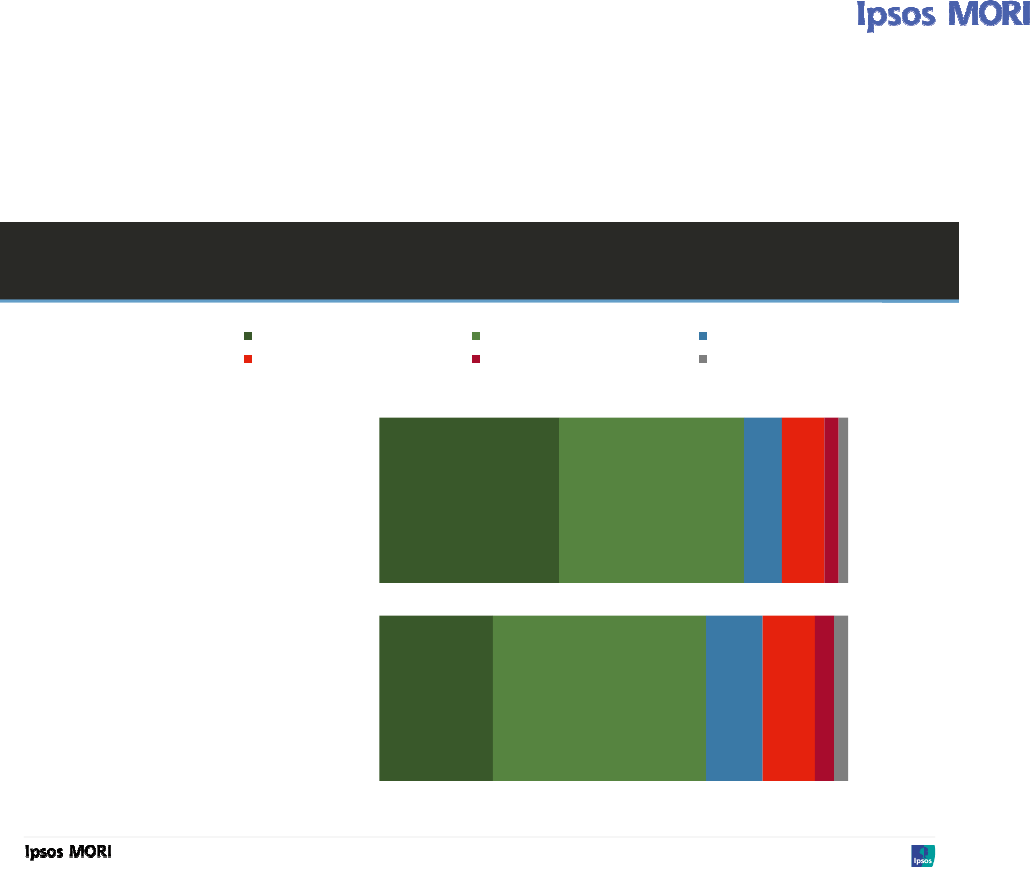
37
The majority agree that charities have a positive impact on wider society. Seven in ten (70%) feel
they are
effective at bringing about social change
(24% agree strongly) and three in four (77%)
agree that they
provide society with something unique
– two in five (38%) agree strongly with this.
However, the overall proportion who agree is lower than it was in 2010 when four in five (82%)
agreed.
Q
–
Thinking about charities in general, to what extent do you agree or disagree with each of the following statements?
© Ipsos MORI
38
24
39
45
8
12
9
11
3
4
2
3
% Strongly agree % Tend to agree % Neither / nor
% Tend to disagree % Strongly disagree % Don't know
Agree
%
77
70
Impact on wider society
Base: Adults aged 18+ in England and Wales – 2012 (1,142); 2010 (1,150)
Charities provide society with
something unique
Charities are effective at bringing
about social change
2012 2010
82
73
Source: Ipsos MORI
As previously mentioned, trust in charities tends to be higher amongst those who believe charities
play an important role and who think charities have a positive impact on society. Those who have
a high level of trust in confidence in charities (a score of 8-10) are:
•
More likely (47% vs. 28%) to regard the role of charities as essential compared with those
who have lower trust (a score of 0-5).
•
More likely to agree that charities are
effective at bringing about social change
than those
with lower trust and confidence (79% vs. 54%).

38
During the qualitative interviews respondents elaborated on the vital role that charities play in
society and their ability to ‘fill in the gaps’ and provide services that aren’t being met by public
sector agencies. However, some maintain that charities would not be needed if “the government
was doing its job properly” and that people in England and Wales shouldn’t have to rely on
charities. Some said charities have taken on greater significance in the current economic climate
and, whilst not necessarily agreeing that charities should have to fill in gaps, feel that people are
increasingly relying on them.
“With the way the economics of the country are, there are a lot of people out of work, a lot of
people are less well off than they were before when times were good and a lot more people are
going to be reliant on charities to try and help them and their families out.”
Male, high trust in charities, familiar with the Charity Commission (Int 9)
Some felt that charities were able to provide a more personal service than public bodies and could
help those who were not eligible for any other help. Their work could be targeted at specific groups
of the population, rather than trying to reach everyone.
“They’re more of a personal service, so therefore their work is aimed at who it’s meant for, rather
than overall.”
Female, low trust in charities, not familiar with the Charity Commission (Int 5)

39
Key Findings
When asked generally, a quarter (25%) of the public say they would feel more
confident if a charity was
providing a public service to them or their family
rather than
another type of service provider – this is a significant increase from 2010 when 19% of
the public said they would feel more confident. Two thirds (65%) say it would make no
difference to their confidence.
When asked about some specific types of service, the largest proportion of people in
each case said that public authorities are best at providing these services, which is in
line with 2010.
Given the choice between charities, private companies or public authorities, the public
think that charities would be best at
providing a caring approach
(47%).
Of the different
types
of services provided, one in five (20%) believes charities are best
at
providing information and advice
; this is higher than in 2010 when one in six (16%)
said this.
(**
Types of service
The public were asked which out of charities, private companies or public authorities would be
best at providing a number of public services including care homes, social housing, leisure or
sports centres, hospitals, schools and information/advice services. For each type of service, the
largest proportion of people said that public authorities would be best at providing these services,
as shown in the following chart. The findings are in line with the 2010 wave of this research.
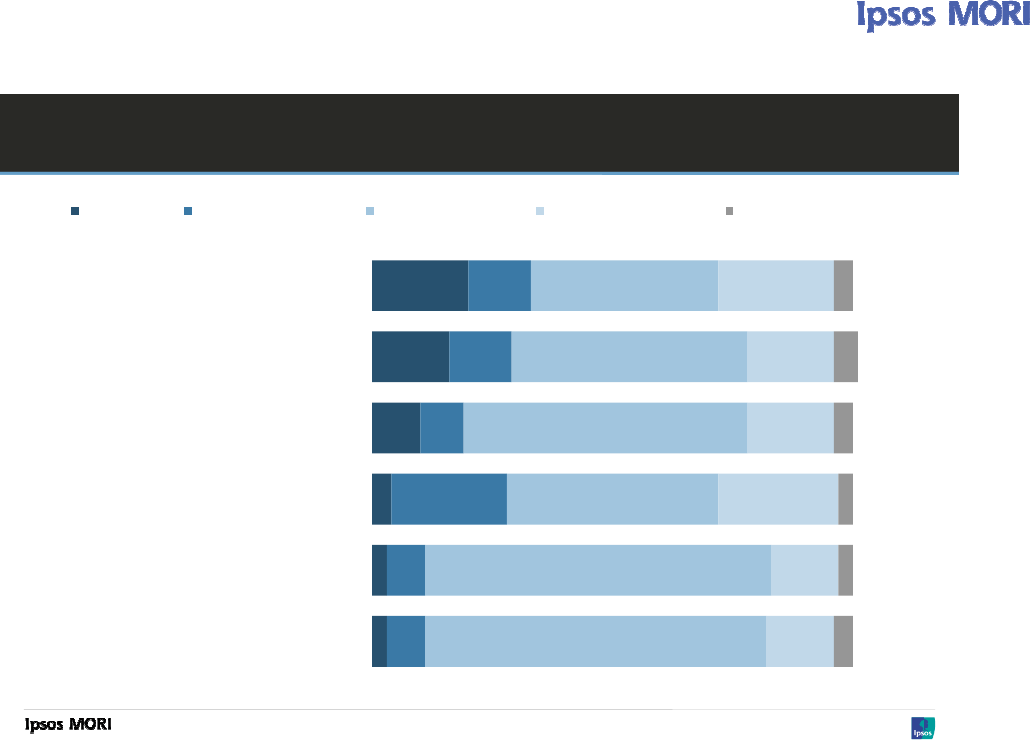
40
Q
–
Which of these – charities, private companies or public authorities – do you think would be best at providing each of
the following types of services or does it make no difference?
© Ipsos MORI
20
16
10
4
3
3
13
13
9
24
8
8
39
49
59
44
72
71
24
18
18
25
14
14
4
5
4
3
3
4
% Charities % Private Companies % Public Authorities % Makes no difference % Don't know
Trust and service provision – type of service
Care homes
Social housing
Leisure or sports centres
Hospitals
Schools
Information and advice, for example
on money, legal or housing issues
Base: Adults aged 18+ in England and Wales – 2012 (1,142); 2010 (1,150)
% Charities
2010
16
14
9
4
3
2
Source: Ipsos MORI
As the above chart shows, the proportion of the public who think charities are best at providing
various services is in line with 2010, though a significantly larger proportion now think charities
would be best at
providing information and advice
(20% vs. 16%).
Middle aged respondents (aged 45-54) are more likely to think charities are the best at
providing
social housing
(16% vs. 10% overall). Older people (aged 65 or over) are less likely to think
charities are best placed to
provide information and advice
(14% vs. 20% overall). Those in social
classes ABC1 are more likely than people in social classes DE to believe charities are best placed
to
provide information and advice
(23% vs. 15%); this perhaps reflects their higher trust and
confidence in charities.
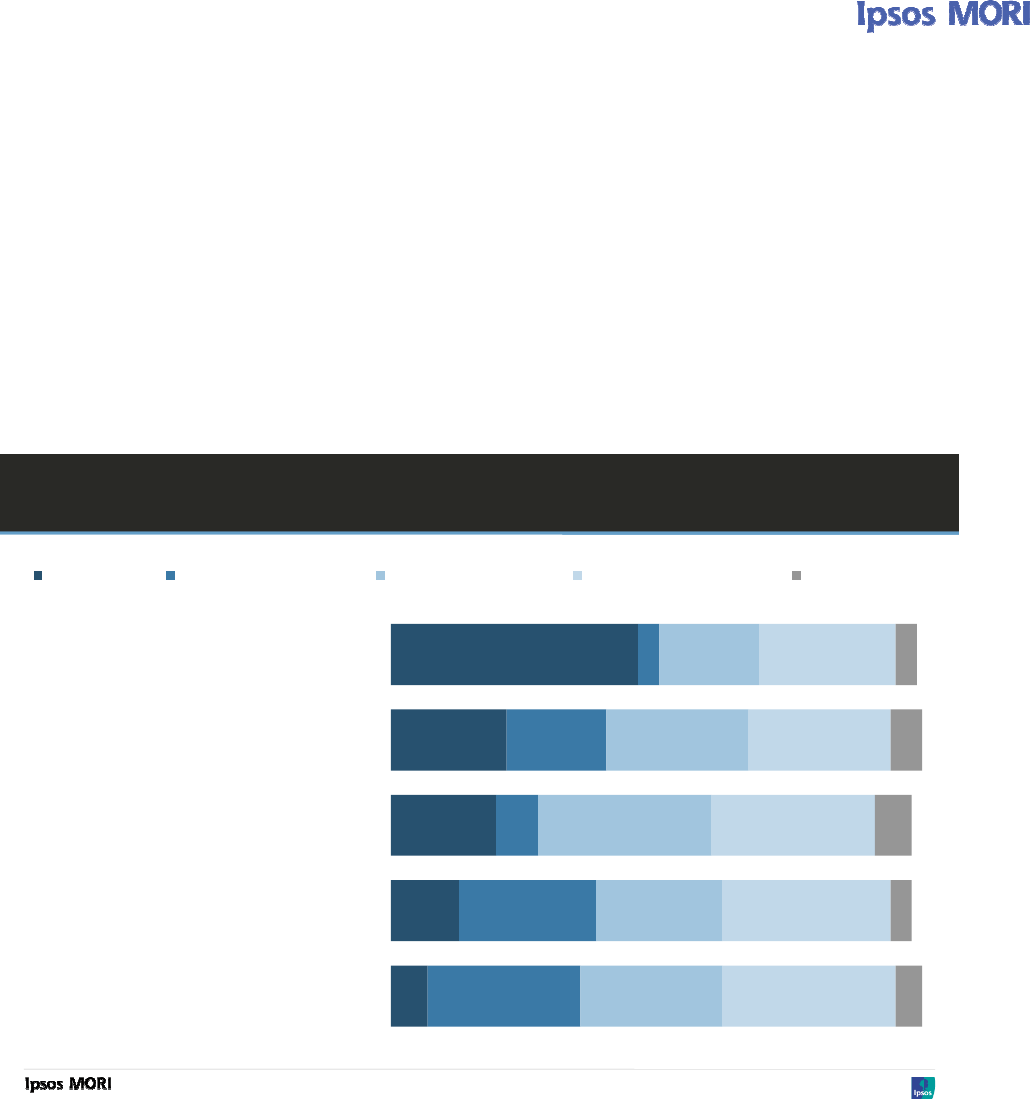
41
Specific aspects of service provision
When asked which of these three would be best in terms of certain attributes or aspects of service
provision, charities are seen as best placed for providing
a caring approach
– around half (47%) of
the public say this, which is significantly higher than in 2010 (40%). Similar proportions of the
public believe that charities and private companies are best placed to providing the
best value for
money
(22% and 19% respectively). This contrasts with 2010 when private companies were
viewed by more people than charities as being best placed to
provide value for money
(24% vs.
18%). However, public authorities continue to be seen as providing the
best value for money
, with
nearly three in ten saying this (27%).
As in 2010, very few people regard charities as best at
providing a professional service
, this was
reflected in the qualitative research as many participants stated that they thought of charities in
terms of ‘not-for-profit’ and ‘voluntary’.
Q
–
Which of these do you think would be best at providing each of the following, or does it make no difference?
© Ipsos MORI
47
22
20
13
7
4
19
8
26
29
19
27
33
24
27
26
27
31
32
33
4
6
7
4
5
% Charities % Private Companies % Public Authorities % Makes no difference % Don't know
Specific aspects of service provision
Providing a high quality service
Providing a professional service
Providing the best value for money
Being open and accountable, for
example to service users and
regulators
A caring approach
Base: 1,142 adults aged 18+ in England and Wales , 4
th
– 21
st
May 2012.
Source: Ipsos MORI
There are some differences in views among certain demographics. Women are more likely than
men to agree that charities are best placed to
provide a high quality service
(16% vs. 11%). Those
aged 45-54 are more likely than average to believe that charities are best at
providing best value
for money
(30% vs. 22%) and
providing a professional service
(11% vs. 7%).

42
Just as they have higher than average trust and confidence in charities overall, younger people
(aged 18-34) are also much more likely than older people (aged 65+) to think charities are the best
at
providing a caring approach
(55% vs.35%). Those aged 18-34 are more likely to say they, or
close family or friends, have ever benefited from or used the services of a charity than those aged
65+ (37% compared to 22%). They are also more likely to say they or a close family member or
friend have
received emotional support or counselling
(27% versus 15% of 65+). This personal
experience may explain why they are more likely to agree that charities are best at providing a
caring approach.
Those in social classes AB are more likely to agree that charities are best placed to be
open and
accountable
(27% vs. 20% overall), which may help explain why they have higher overall levels of
trust and confidence in charities. Furthermore, those who work for a charity are also particularly
likely to think charities are the best at
being open and accountable
(27%).
For most (65%), if they needed support from a public service it would, hypothetically, make no
difference to them whether it was provided by a charity or another type of service provider.
However, one in four (25%) would feel more confident (compared with 19% in 2010), while eight
percent would be less confident.
Q
–
Thinking generally, if you or your family needed support from a public service, would you be more or less confident if
the service was provided by a charity than another type of service provider, or would it make no difference?
© Ipsos MORI
Confidence in services provided by charities
No difference
Much more confident
Don’t know
Slightly less confident
A little more confident
Much less confident
Base: 1,142 adults aged 18+ in England and Wales, 4
th
– 21
st
May 2012.
Source: Ipsos MORI

43
Exploring this issue in a qualitative manner, when asked directly about the ability of charities to
provide certain public services, opinion is not clear cut. On the one hand, there is the belief that
the charities are more naturally suited to helping people and providing a more personal service
than private companies that are motivated by profit. Generally, this was not an issue that had been
widely considered amongst participants and they were unsure of their views.
“At the end of the day they (private companies) are businesses to make money, whereas
charities…are more humane in their dealings with people.”
Male, low trust in charities, not familiar with the Charity Commission (Int 3)
Some concerns were raised, however, over the appropriateness of charities providing services
that have been traditionally provided by the public sector. There was a sense that some services
should be provided by the state and charities should not be required to fulfil them. Concerns were
also raised that the government providing funding to charities just adds another layer of
bureaucracy to service provision.

44
Key Findings
Awareness among the general public of the Charity Commission has remained in line with
2010 (55% in 2012 and 53% in 2010).
Once explained, nearly all (98%) believe that the role of the Charity Commission is
essential, very or fairly important. This reflects the strong feelings the public have around
ensuring charities’ funds are used appropriately.
The qualitative research reveals that people do tend to think about regulation of charities
but only in broad terms, and tend to make assumptions about what is monitored. There
was some feeling that charities are not effectively monitored or regulated at present,
especially with respect to fundraising.
+
Awareness and familiarity
Just over half of respondents (55%) have heard of the Charity Commission. Public awareness of
the Charity Commission remains consistent with 2010 and 2008 (when 53% and 54% respectively
had heard of it). Interestingly, awareness is lowest in London (47%), where we also see the lowest
levels of overall trust in charities.
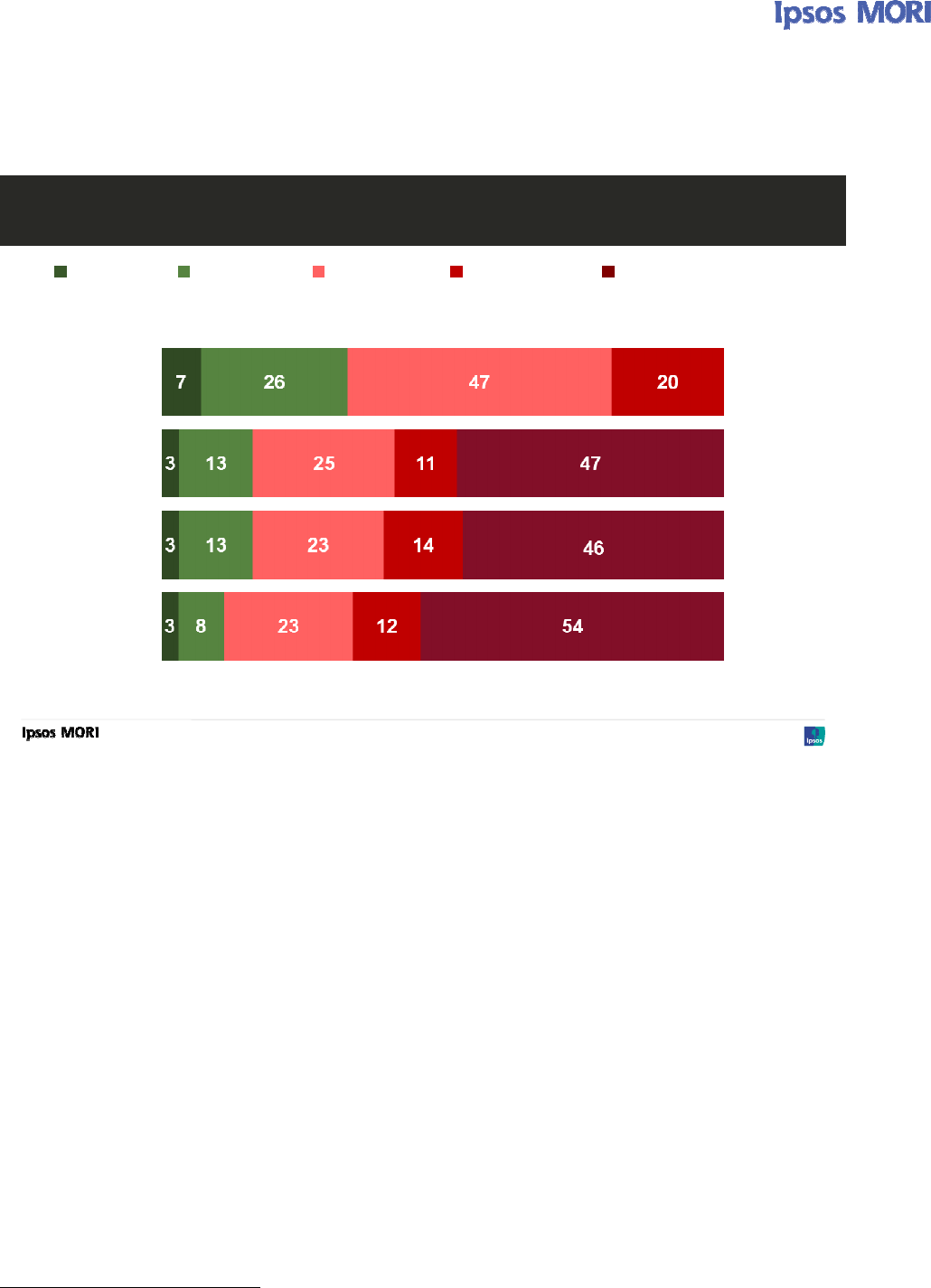
45
Of those aware of the Charity Commission, a third (33%) feel that they know the Commission
either very or fairly well, which is in line with 2010 (32%). This equates to around 18% of the adult
population of England and Wales as a whole.
Q – How well, if at all, do you feel you know the Charity Commission and what it does?
© Ipsos MORI
Level of knowledge about the Charity Commission
% Not very well % Not at all well% Very well % *Fairly well
2010
2008
2005
Base: Adults aged 18+ in England and Wales – 2012 (1,142); 2010 (1,150); 2008 (1,008); 2005 (1,001)
* Option changed to ‘fairly well’ for 2008 and 2010 from ‘quite well’ in 2005
Know Charity
Commission ‘well’
%
17
16
11
% Never heard of/don’t know
2012
33
Source: Ipsos MORI
Men are more likely than women to say they have heard of the Commission (63% vs. 48%). As
was true in 2010, older people (aged 45+) remain more likely than younger generations (aged 18-
34) to have heard of the Charity Commission (66% vs. 34%). Those in social classes ABC1 are
also significantly more likely than those in classes C2DE to have heard of the Charity Commission
(65% vs. 43% overall) and those who personally, or have close friends or family that work for or
are a beneficiary of a charity (66% and 61% respectively vs. 55% overall). Importantly, when
thinking about the role that the Charity Commission plays in society, most of these groups also
have higher overall trust in charities (the exception is older people – younger people are in fact
more likely to have higher trust).
Although only around half (55%) have heard of the Charity Commission, there is much wider
consensus on the importance of the Charity Commission’s role once this is explained
6
. Just over
half (56%) feel its role to be essential, a further third (35%) feel it to be very important, and seven
percent say it is fairly important. In total, 98% feel the Charity Commission’s role is important.
Explanation given: The Charity Commission is an independent body responsible for registering and regulating charities
in England and Wales. They register applicants for registration as a charity after examining their purposes, accounts and
structure. They regulate charities by ensuring they stay within the law and are run for the public benefit, and by
investigating any allegations of wrong-doing by charities.
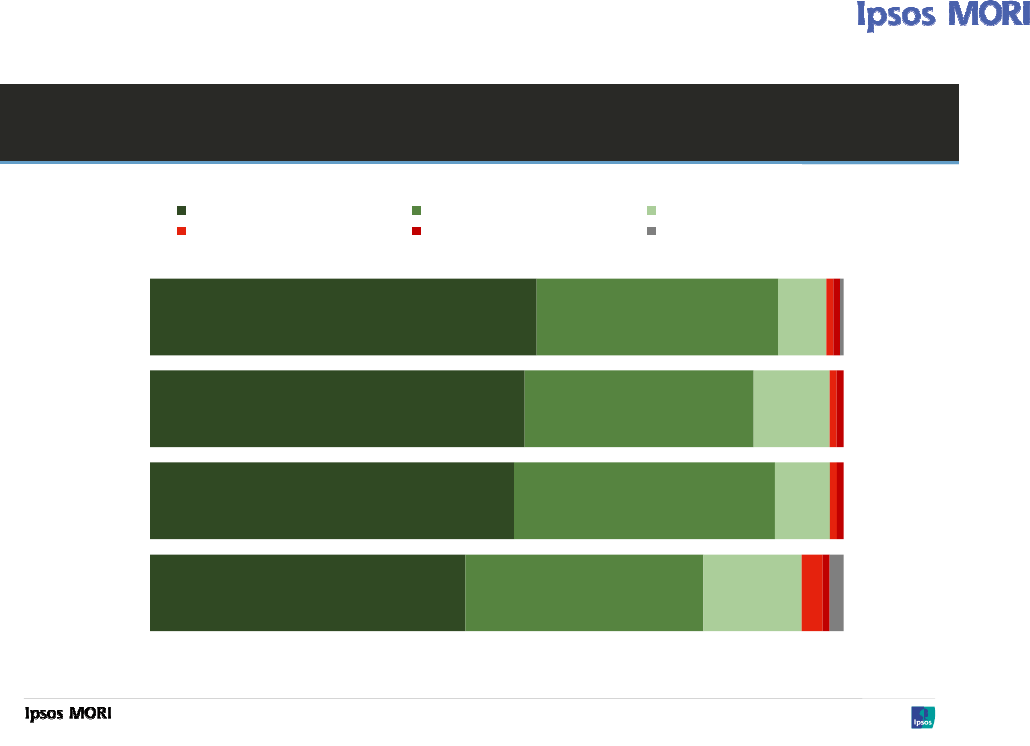
46
Q
–
How important do you personally regard this role?
© Ipsos MORI
56
54
53
45
35
33
38
34
7
11
8
14
1
1
1
3
1
1
1
1 2
% Essential* % Very important % Fairly important*
% Not very important % Not at all important % Don't know
Importance of Charity Commission’s role
2012
2008
2005
Base: Adults aged 18+ in England and Wales – 2012 (1,142); 2010 (1,150), 2008 (1,008), 2005 (1,001).
*Question options ‘Extremely important’ and ‘Quite important’ in 2005 instead of ‘Essential’ and ‘Fairly important’.
% ‘essential/
important’
98
98
94
98
2010
Source: Ipsos MORI

47
Understanding the issue of regulation
Qualitatively, the regulation of charities is something those interviewed are vaguely aware of, but
generally have not necessarily considered much prior to this research.
“If they’re regulated, they probably have to provide information to people to show where the
money’s been spent, but it’s not something I would actually look into.”
Male, low trust in charities, not familiar with the Charity Commission (Int 3)
Those who are not familiar with the Charity Commission suggest various ways in which they would
try to determine the legitimacy of a charity such as looking for a registered charity number and
using the internet to search for a website or any discussion of the charity.
There is some awareness amongst those who are aware of the Charity Commission, about how it
regulates charities. Awareness is higher among those who are currently personally involved with
charities and or worked or volunteered for charities in the past.
“Charities have to be registered with the Charity Commission. They have to submit their accounts
and suchlike. They have to do annual returns, more people should be aware of that.”
Male, high trust in charities, familiar with the Charity Commission (Int 4)
A few of those interviewed question the Charity Commission’s ability to regulate in an effective
manner and feel that the body may lack the appropriate sanctions to effectively address and deal
with transgressions. Participants were generally ambivalent when informed about the Charity
Commission and what it does. While some said it is comforting to know that there is a regulator out
there, there was some cynicism concerning how effective it can be.
“I think the general public need that security to know that somebody’s watching where their money
goes to and that it does what it says it’s going to do.”
Male, low trust in charities, not familiar with the Charity Commission (Int 5)
The idea of a more
proactive
investigation into whether a charity is meeting its objectives and how
it is spending money is suggested by some. There is, however, agreement that they want to know
that
someone
is ensuring that charities are legitimate, well-run and spending donations effectively.

48
Charity beneficiaries
A third of respondents (34%) say they have benefited from, or used the services of a charity when
asked directly, this is a small but significant increase since 2010 when three in ten (30%) said they
had.
When prompted with a wider range of activities and services that charities might provide, which
may not all be as readily associated with a charity, the vast majority (94%) report having benefited
personally, or having close family or friends who have benefited, in some way from organisations
likely to be classed as charities. This is detailed in the following chart.
Key Findings
A third of respondents (34%) say they have benefited personally, or had close friends or
family benefit from a charity. However, when prompted with specific examples, a much
greater proportion say they or close friends/family have, for example,
visited an art
gallery (73%) or a National Trust propert
y (71%). In addition, half (52%) say they have
attended a youth group
, and over a third have
used the services of a charity
(37%).
In total, over a third (37%) of the public are personally involved with charities, or have
close friends or family members who are in involved with charities. This is higher than in
2010 when the figure was 32%.
Being a beneficiary or actively involved with a charity (or having close friends/family that
are) is linked to higher overall trust and confidence in charities. For example, those with
high trust and confidence in charities (a score of 8-10) are more likely than those with no
to medium trust and confidence (a score of 0-5) to be personally involved, or have close
friends of family involved, with a charity (42% vs. 28%).

49
Q
–
Have you, or any of your close family or friends, ever done any of the following?
© Ipsos MORI
Charity beneficiaries
73%
71%
52%
46%
37%
37%
30%
26%
22%
20%
Visited a National Trust property
Visited an art gallery
Attended a youth club provided by a charity (e.g.
Guides or Scouts)
Attended or had a child who attended university
Used the services of a charity
Received advice from a charity
Telephoned a charity’s information or helpline
Received emotional support or counselling
from a charity
Been a patient in a local hospice
Received personal care from charity workers
Top mentions only (20% and above)
Base: 1,142 adults aged 18+ in England and Wales, 4
th
– 21
st
May 2012
Source: Ipsos MORI
Older people aged 65+ are less likely to say that they have personally benefited from a charity (or
have close family or friends who have benefited from a charity), one in five (22%) of those aged
65+ say they have benefited compared with two in five (38%) of those aged 18-64. This is also
true for all the options on the prompted list excluding
visited a National Trust property
. As the
question asks about experience of close friends or family as well as the individual, the potentially
smaller social circle of older people should be considered when interpreting these results. People
with high trust and confidence in charities are more likely to say that they or close friends or family
have benefited from or used the services of a charity; 36% of people who gave a trust and
confidence rating of 5 or more say they have benefited compared with 22% of those who with no
or a low trust and confidence rating (a score of 0-4). This again demonstrates the relationship
between awareness, familiarity and use of charities and trust and confidence in them.

50
Active public involvement with charities
Over a third (37%) say they, or close friends or family members, are actively involved with charities
in some capacity (either as an employee, volunteer or trustee) compared to 32% in 2010, 36% in
2008, and 28% in 2005.
Q – Do you or any of your close family or friends work for a charity, either as a paid employee, a trustee, a volunteer, or
member of a charity’s executive or management committee?
© Ipsos MORI
Active involvement with charities
Yes – paid employee
Yes – trustee
Yes – volunteer
Yes – member of a charity’s executive
or management committee
No
Don’t know
Yes (total)
9%
4%
26%
3%
62%
1%
37%
9%
4%
19%
4%
68%
1%
32%
8%
5%
24%
4%
63%
36%
6%
3%
21%
2%
72%
28%
Yes other = 1% in 2012.
Base: Adults aged 18+ in England and Wales – 2012 (1,142); 2010 (1,150); 2008 (1,008), and 2005 (1,001).
Source: Ipsos MORI
2012
2008
2005
2010
People living in Wales are least likely to have active involvement with charities, with significantly
more people saying no (72%) than average (62%).
As might be expected, those who personally work for a charity, or have close friends or family that
do so, are more likely than those who do not to give a higher overall trust rating (42% give a score
of 8-10 vs. 34% of those who do not).
Those in social classes ABC1 are more likely to work for a charity, or have close friends or family
that do so (44% vs. 30% of those in classes C2DE). People in social classes AB have higher trust
and confidence in charities generally.
This reflects the qualitative research findings: those who are actively involved with a charity, for
example as a trustee or volunteer, tend to have more faith in charities more generally, as they feel
more informed about how they operate.

51
,

52
,
Approach
Key Drivers Analysis (KDA) is a multivariate technique that has been used to identify how strongly
attitudes and behaviour towards charities are associated with overall trust and confidence in
charities. It is arguably a more ‘objective’ measure of what drives overall trust and confidence as it
examines a range of responses that people give to a number of questions throughout the survey
rather than relying simply on what people
say
is most important to them when asked directly. A
good example of this working in practice is in the context of staff satisfaction surveys, where
employees often cite pay as most important to them when asked directly, but KDA can reveal that
other factors, such as finding their day-to-day work interesting and varied for example, are in fact
more strongly associated with overall job satisfaction.
KDA performed on the 2005 trust and public confidence survey showed that overall trust and
confidence was primarily explained by five key beliefs in how charities operate, namely: the belief
that charities spend their money wisely and effectively; are well managed; ensure that a
reasonable proportion of donations make it to the end cause; make a positive difference to the
cause they work for; and ensure that fundraisers are ethical and honest.
The 2008 research looked to build on the insights of the 2005 KDA by ‘unpacking’ the five key
beliefs, which have been shown to drive overall trust and confidence, enabling further insight into
the results. A two-tiered approach was used. Question three in the survey asks respondents to
directly state which one of the five qualities is most important to their trust and confidence in
charities overall, showing the reported relative importance of each of the five key beliefs on overall
trust and confidence. For the first (top) tier of the Key Drivers Analysis we conduct regression
analysis to identify the correlation of these five variables with the first question in the survey, in
which respondents state their level of overall trust using a ten point scale. This allows us to identify
which of these attributes at Q3 are strongest drivers of trust at Q1.
The second (lower level) analysis then uses regression analysis to explore the correlations
between these five beliefs and other questions included in the survey to identify the key drivers of
these attributes.
In 2010, a change was made to the questionnaire, replacing the measure
trust in charities to
spend their money wisely and effectively,
with
trust in charities to make independent decisions to
further the cause they work for.
In order to investigate the relative importance of this belief in
comparison to the other four key beliefs a two-tiered KDA approach was again conducted.
In 2012, the two-tiered approach has been maintained, but a slightly different regression technique
has been used called ‘categorical regression’ which provides a more reliable approach to model
categorical variables. This approach is particularly suited to datasets based on large number of
response variables based on Likert scales. In essence, categorical regression enables the
selection of drivers to only those factors that have a strong and unequivocal impact on the
measure of interest, allowing us to focus in on the most relevant drivers for each model.
In 2012, the following questions were included in the second tier analysis (see appended topline
for full details): Q6, Q7, Q10a, Q10b, Q11, Q13 (a and b combined), Q14, Q14g.

53
Findings
When asked to select which one quality is most important to their trust and confidence in charities
overall 43% of the public state
ensure a reasonable proportion of donations make it to the end
cause
, while 31% say
make a positive difference to the cause they are working for
. A lower
proportion (13%) select
ensure that its fundraisers are honest and ethical
.
However, in the 2012 Key Drivers Analysis ensuring charities
make a positive difference to the
cause they are working for
comes through as the strongest driver of overall trust in charities.
Ensuring a reasonable proportion of donations make it to the end cause
is much lower in the Key
Drivers Analysis than the direct question ranking. This indicates that while respondents may state
the importance of donations reaching the end cause, it is actually the impact that charities have
that has the strongest impact on their overall trust levels.
We can see this elsewhere in the data set where the proportion of the public who feel charities
play an essential role in society has increased, along with an increase in the proportion of people
who or whose close friends/family use various charitable services, highlighting the increasing
levels of direct experience that people have of charitable services. We know through the sub-
group data analysis that people who have had direct experience of charities tend to have higher
overall trust levels.
This shows an interesting contrast in perceptions of the sector – negative media stories about
wastage have a hugely negative impact on the sector as a whole, which is possibly leading to
respondents citing donations reaching the end cause as a more top of mind issue that drives trust
in charities. This would be in response to this assumption having been challenged by the media.
However, positive levels of trust are actually more likely to be driven by user experience and the
good work that charities do. It would appear that positive perceptions can be overshadowed by
these negative stories.
This is supported by the Key Drivers Analysis
–
in reality each of the five measures are quite
closely intertwined and it is just
ensuring a reasonable proportion of donations make it to the end
cause
that stands up by itself as a Key Driver i.e. in a more conservative running of the model to
remove attributes that are not intertwined this would likely be one of the few remaining drivers that
holds in isolation (another would possibly be
ensure that its fundraisers are honest and ethical
.)
The following KDA model presents the results of this first tier of analysis graphically:
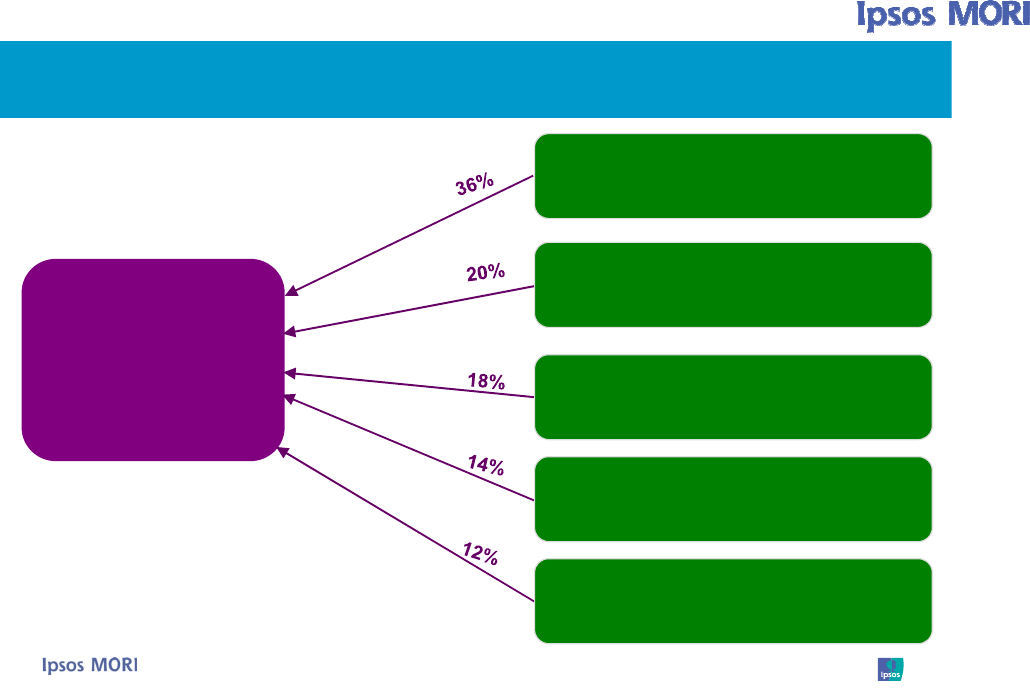
54
Overall trust and
confidence in
charities
($
-
Ensure that its fundraisers are
honest and ethical
Make independent decisions to
further the cause they work for
Make a positive difference to
the cause they are working for
Ensure that a reasonable
proportion of donations make it
to the end cause
70% of total variation in the results
is explained by the model
Be well managed
1% of the balance of explained variance is due to
controls (social grade and ethnicity)
NB ‘% of total variation in the results is explained by the model’ refers to the strength of each
model; that is to say, the amount of each measure (in this case ‘overall trust and confidence in
charities’ that is explained by the contributing variables in the model (those listed on the right hand
side).
‘% of the balance of explained variance’ refers to the breakdown of the explained variance into the
contribution by each driver to that explained variance; hence the sum in each model is always
100%.
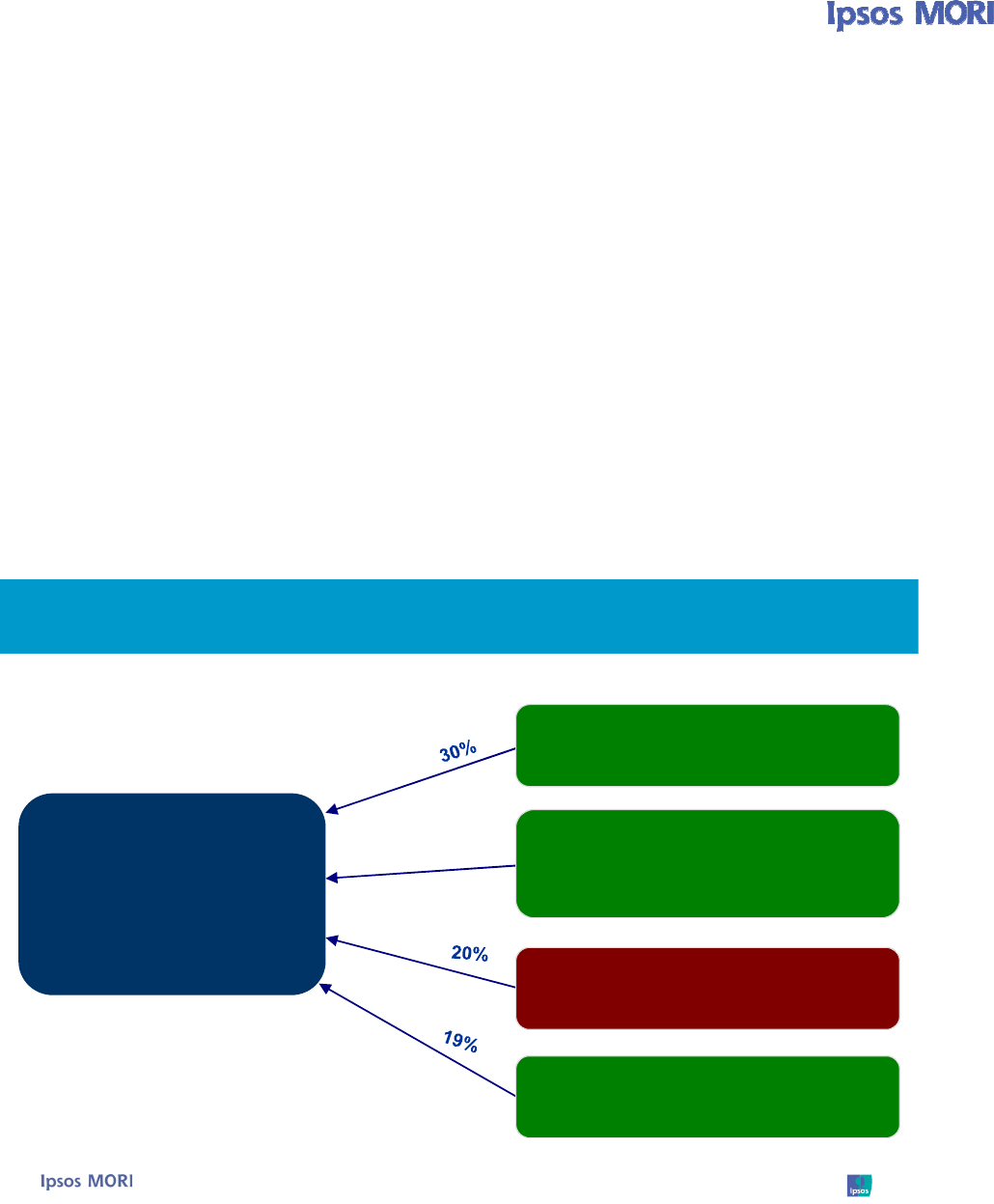
55
The second tier analysis, conducted for each of the five key belief measures is illustrated below.
The beliefs and attitudes shown in green are positive drivers. For example, looking at the first
chart,
most charities are trustworthy and act in the public interest
is a positive driver, meaning that
agreement with this statement is strongly associated with
higher
levels of
trust in charities to make
independent decisions
. The beliefs shown in red are negative drivers, for example,
charities spend
too much of their funds on salaries and administration
, meaning that agreement with this is
associated with
lower
levels of trust in
charities to make independent decisions.
There is a degree of consistency in the factors most strongly associated with each quality of a
charity across the five tier two models. Like 2010, agreement that
most charities are trustworthy
and act in the public interest
consistently appears as a driver of higher trust scores across all five
qualities, while agreement that
charities spend too much of their funds on salaries and
administration
is consistently associated with a lower trust score. Again, this indicates the large
impact that negative media coverage can have.
With regard to positive drivers, user experience and an appreciation of the important societal role
that charities play is particularly important – for example, positive responses to the question
overall, how important do you think charities play in society today
are particular drivers of trust in
charities to
make a positive difference to the cause they’re working for
.
Trust in charities to:
make independent
decisions to further the
cause they work for
(
-
.
*
33% of total variation in the results
is explained by the model
7% of the balance of explained variance is due to
controls (working status and ethnicity)
Most charities are trustworthy
and act in the public interest
(Q6)
Charities are regulated and
controlled to ensure that they
are working for the public
benefit (Q6)
I trust charities to work
independently (Q6)
Charities spend too much of
their funds on salaries and
administration (Q6i)
24%

56
A particular concern of the public is that too great a proportion of donations is spent on
administration and advertising compared with the end cause. Unsurprisingly, then, the view that
charities spend too much on salaries and administration
has a strong negative association with
trust in charities to ensure that a reasonable proportion of donations
make it to the end cause, as
shown below.
Trust in charities to:
ensure that a
reasonable
proportion of
donations make it to
the end cause
(
-
I trust big charities more than smaller ones
(Q6)
I feel confident donating to a charity even if I
haven’t heard of them, if it’s going to a good
cause (Q6)
Some of the fundraising methods used by
charities make me uncomfortable (Q6)
I trust charities more if I have heard of them
(Q6)
38% of total variation in the results
is explained by the model
8% of the balance of explained variance is due to
controls (gender, working status and ethnicity)
Charities spend too much of their funds on
salaries and administration (Q6)
Charities are effective at bringing about social
change (Q14)
Most charities are trustworthy and act in the
public interest (Q6)
11%
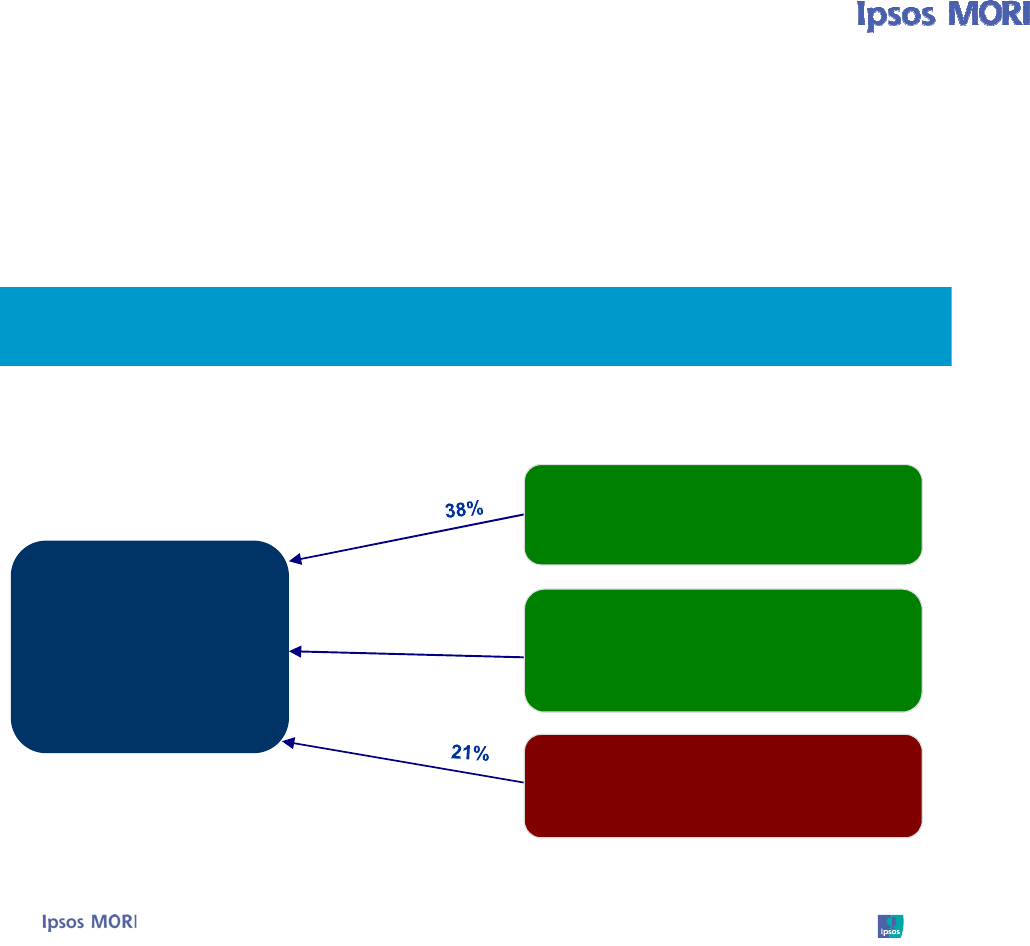
57
Thinking specifically about the Charity Commission's role, regulation is very important for the
public in relation to their
trust in charities to ensure that fundraisers are honest and ethical
.
Agreement that
charities are trustworthy and act in the public interest
is the strongest driver. This
is clearly an intuitive relationship, and one which appears to a degree in the qualitative research
with the link between techniques of fundraisers and feeling that charities are acting in the public
interest.
Thinking that
charities are regulated and controlled
is a relatively strong second driver, having also
been the second-highest driver in 2010.
(
-
.
27% of total variation in the results
is explained by the model
Trust in charities to:
ensure that its
fundraisers are
honest and ethical
Charities are regulated and
controlled to ensure that they
are working for the public
benefit (Q6)
Charities spend too much of
their funds on salaries and
administration (Q6)
Most charities are trustworthy
and act in the public interest
(Q6)
9% of the balance of explained variance is due to
controls (working status and ethnicity)
32%
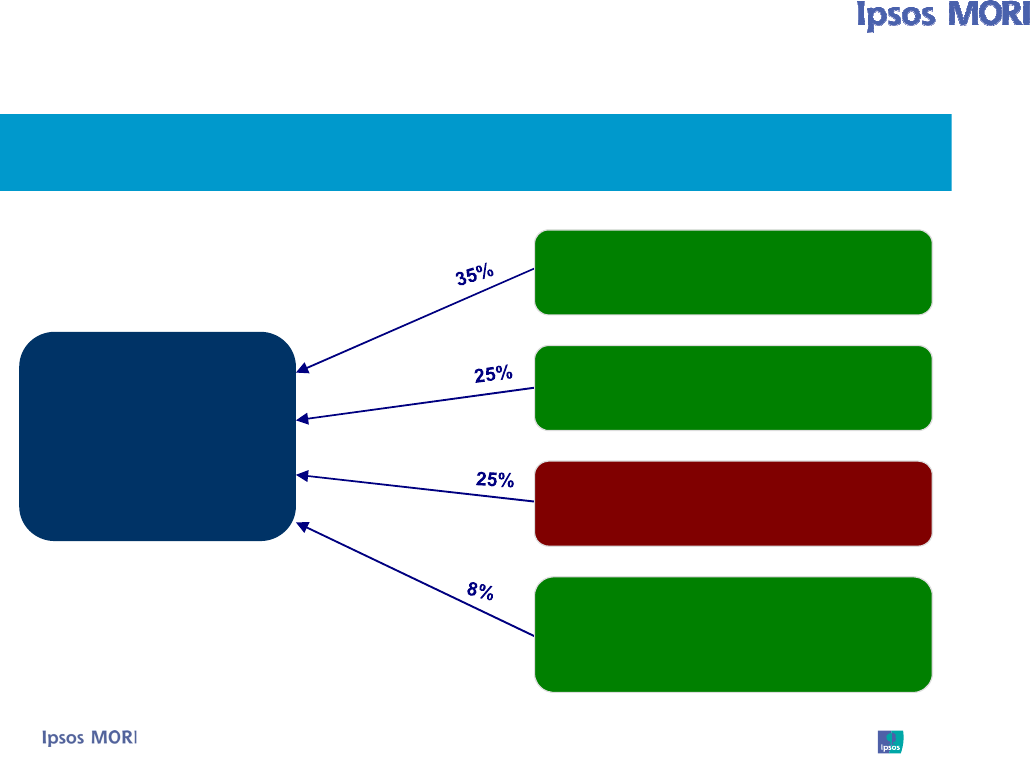
58
The chart below shows that believing that
most charities are trustworthy and act in the public
interest
is a key driver of
believing that charities are well managed
(- +
33% of total variation in the results
is explained by the model
Trust in charities to:
be well managed
7% of the balance of explained variance is due to
controls (gender, working status and ethnicity)
Charities are effective at
bringing about social change
(Q14)
Most charities are trustworthy
and act in the public interest
(Q6)
I feel confident donating to a
charity even if I haven’t heard
of them, if it’s going to a good
cause (Q6)
Charities spend too much of
their funds on salaries and
administration (Q6)

59
There is a clear association between those who think positively about the importance of charities’
role in society today and trust in charities to
make a positive difference to the cause they are
working for
. Equally intuitively, the feeling that
most charities are trustworthy and act in the public
interest
is driving trust in charities to
make a positive difference to the cause they are working for
,
as shown below.
(
-
.*
+ .
43% of total variation in the results
is explained by the model
Trust in charities to:
make a positive
difference to the
cause they are
working for
15%
8% of the balance of explained variance is due to
controls (working status and ethnicity)
I trust charities more if they are providing
services within my local community (Q6)
Charities are effective at bringing about social
change (Q14)
I know very little about how charities are run
and managed (Q6)
Charities are regulated and controlled to
ensure that they are working for the public
benefit (Q6)
Most charities are trustworthy and act in the
public interest (Q6)
I trust charities more if I have heard of them
(Q6)
Overall, how important a role do you think
charities play in society today? (Q7)

60
/**

61
/**
Guide to statistical reliability
The sampling tolerances that apply to the percentage results are given in the table below. This
table shows the possible variation that might be anticipated because a sample, rather than the
entire population, was interviewed. As indicated below, sampling tolerances vary with the size
of the sample and the size of the percentage result. For example, on a question where 50% of
the people in a sample of c.1,150 respond with a particular answer, the chances are 95 in 100 that
this result would not vary by more than 3 percentage points, plus or minus, from a complete
coverage of the entire population using the same procedures (i.e., between 47% and 53%).
Approximate sampling tolerances applicable to percentages at or near these levels
10% or
90%
20% or
80%
30% or
70%
40% or
60%
50%
Size of sample on which
survey result is based
1,142 2 2 3 3 3
Source: Ipsos MORI
Tolerances are also involved in the comparison of results from different parts of the sample. A
difference, in other words, must be of at least a certain size to be considered statistically
significant. The following table is a guide to the sampling tolerances applicable to comparisons.
It should be highlighted that these tolerances are based on perfect random samples, and design
effects such as clustering and weighting are likely to increase them. In practice, good quality quota
sampling has been found to be as accurate as random samples with a similar design.
Approximate differences required for significant at or near these percentages
10% or
90%
20% or
80%
30% or
70%
40% or
60%
50%
Men vs. Women (532 vs.
610)
4 5 5 6 6
18-24 year olds vs. 65+
(295 vs. 256)
5 7 8 8 8
Source: Ipsos MORI

62
Topline findings
1,142 respondents aged 18+ across England and Wales
Interviews carried out by telephone, using CATI (Computer Assisted Telephone Interviewing)
Fieldwork conducted between 4 and 21 May 2012.
Results based on all unless otherwise stated.
Results are weighted to the known population profile of England and Wales.
An asterisk (*) denotes a finding of less than 0.5%, but greater than zero.
Where figures do not add up to 100, this is due to multiple coding or computer rounding.
Where available, trend data from 2005, 2008 and 2010 has been added.
Fieldwork for the 2010 survey was conducted between 7 and 17 May 2010. Results for 2010 are based on
all (1,150) unless otherwise stated.
Fieldwork for the 2008 survey was conducted between 8 and 24 February 2008. Results for 2008 are based
on all (1,008) unless otherwise stated.
Fieldwork for the 2005 survey was conducted in February 2005. Results for 2005 are based on all (1,001)
unless otherwise stated.
OVERALL TRUST METRIC
ASK ALL
Q1.
Firstly, thinking about how much trust and confidence you have in charities overall, on a
scale of 0-10 where 10 means you trust them completely and 0 means you don’t trust them at
all, how much trust and confidence do you have in charities? IF DEPENDS: Generally
speaking, how much trust and confidence do you have in charities? SINGLE CODE ONLY
0
Don’t
trust
them
1 2 3 4 5 6 7 8 9
10
Trust them
completely
DK/
No
answer
Mean
2012
%
2 * 2 3 3 16 13 23 23 8 6 2 6.68
2010
%
1 1 2 4 4 17 10 19 26 9 5 1 6.64
2008
%
1 1 2 3 4 18 11 22 22 8 6 1 6.56
2005
%
3 1 3 3 5 23 10 19 20 5 6 3 6.27

63
TRUST AND PERFORMANCE
ASK ALL
Q2.
And on the same 0
-
10 scale, how much would you trust charities to…
READ OUT A-E RANDOMISE ORDER
0
Don’t
trust
them
1 2 3 4 5 6 7 8 9
10
Trust
them
completely
DK/
No
answer
A
Make
independent
decisions,
to further
the cause
they work
for
2005
%
N/A N/A
N/A
N/A
N/A
N/A
N/A
N/A
N/A
N/A
N/A N/A
2008
%
N/A N/A
N/A
N/A
N/A
N/A
N/A
N/A
N/A
N/A
N/A N/A
2010
%
1 1 2 2 3 17 12 19 24 8 7 2
2012
%
2 1 2 2 4 14 13 20 22 9 6 5
B
Ensure that
a
reasonable
proportion
of donations
make it to
the end
cause
2005
%
2 1 5 7 7 19 12 18 14 6 5 4
2008
%
2 2 3 7 7 18 15 20 15 5 5 2
2010
%
1 2 4 5 8 15 14 21 18 6 5 1
2012
%
2 1 4 5 7 17 16 17 17 7 5 2
C
Ensure that
its
fundraisers
are honest
and ethical
2005
%
2 * 2 3 5 17 13 19 20 6 8 4
2008
%
1 1 1 3 6 15 12 21 23 8 7 2
2010
%
1 1 2 2 4 16 12 18 24 10 8 1
2012
%
2 * 2 2 4 13 15 20 22 10 7 2
D
Be well
managed
2005
%
1 1 3 4 7 21 13 17 18 4 6 4
2008
%
1 1 2 4 5 18 15 21 19 6 5 2
2010
%
1 1 3 3 5 15 14 21 22 7 6 2
2012
%
2 1 1 4 5 14 15 25 20 7 5 3
E
Make a
positive
difference to
the cause
they are
working for
2005
%
1 * 1 4 3 14 11 17 23 11 11 3
2008
%
1 1 2 3 4 13 11 22 22 11 9 2
2010
%
1 1 2 2 3 15 8 18 24 15 10 1
2012
%
1 1 1 2 4 8 9 20 28 13 12 2

64
ASK ALL
Q3.
Which one, if any, of these qualities is
most
important to your trust and confidence in
charities overall?
RANDOMISE ORDER. REPEAT LIST IF NECESSARY. SINGLE CODE ONLY
2005
2008
2010
2012
% % % %
Ensure that a reasonable
proportion of donations make it
to the end cause
30 32 42 43
Make a positive difference to the
cause they are working for
27 35 31 31
Ensure that its fundraisers are
honest and ethical
11 8 15 13
Be well managed
9 5 8 9
Make independent decisions, to
further the cause they work for
n/a n/a 3 3
Don’t know
3 2 1 1

65
TRUST AND SPECIFIC CHARITIES
ASK ALL
Q4A.
Are there any specific charities or types of charities that you would trust
more
than
others? DO NOT PROMPT. IF YES PROBE FOR NAMES
TOP MENTIONS ONLY – 1% OR MORE (2012)
2005
2008
2010
2012
% % % %
Charities by name
Cancer Research UK
12 15 12 12
Oxfam
6 9 4 6
British Heart Foundation
3 4 5 5
British Red Cross
4 4 3 5
Macmillan Cancer Support
1 6 3 4
NSPCC
4 9 6 4
RSPCA
2 6 3 3
Save the Children
2 3 1 3
The Salvation Army
2 2 2 3
Barnardo's
* 2 1 2
RNLI
1 4 2 2
Christian Aid
1 2 1 2
Marie Curie
- 2 1 1
Air Ambulance
1 1 1 1
Age UK (Combination of Age
Concern + Help the Aged)
1 2 1 1
British Legion
- 2 1 1
Unicef
1 1 1 1
Guide Dogs for the Blind
* 1 1 1
ChildLine
1 2 1 1
Breakthrough Breast Cancer
* 1 1 1
Alzheimer’s Society
* * * 1
WaterAid
* * * 1
National Trust
* 1 * 1
Samaritans
* 1 * 1
CAFOD
- 1 * 1
WWF
* 1 1 1
Scope
* * 1 1
Amnesty International
1 1 1 1
MS Society
* * 1 1
Charities by type
Health-related charities
2 2 4 6
Local charities
3 5 3 6
Animal charities
3 4 4 6
Well-known charities
1 4 4 5
Children’s charities
3 3 2 4
Small charities
* 2 2 3
Big charities
3 2 2 3
Hospital/hospice charities
N/A N/A 1 3
Cancer charities
3 2 2 2
Religious charities
2 3 2 2
Armed Forces charities/Help for
Heroes
- - 1 2
UK/British based charities
N/A N/A 1 1
Environmental/farming charities
- - * 1
Charities that alleviate hardship
* 1 1 1
International charities
2 1 1 1
Don’t know/None
50 34 39 36
Plus
‘o
ther’ responses – not shown (11% in 2012, inc. responses of less than 1%)

66
ASK Q4B OF ALL THOSE WHO MENTIONED A CHARITY (OR CHARITY TYPE) AT Q4A. ASK Q4B FOR
EACH CHARITY/CHARITY TYPE MENTIONED AT Q4A.
Q4B.
Why do you say that? Why do you trust xxx more than others?
DO NOT PROMPT. MULTICODE OK
TOP MENTIONS ONLY – 2% OR MORE (2012)
2005
2008
2010
2012
Base: All who mention a
charity/charity type
(725) (678) (702) (742)
% % % %
Because I have seen/ experienced
what they do
27 38 39 38
Because I believe in the cause/
what they are trying to do
25 30 25 31
Because they have a good
reputation†
- 24 21 27
Because they are well-known†
- 23 21 20
Because they do an important job
11 15 7 17
Because I have heard (lots) about
them
6 10 9 13
Because they are set up for the
public good
6 10 8 9
Because they are regulated
8 6 5 9
Because they are big
5 9 6 8
Because they are local
2 7 5 8
Because they are small
- 2 2 4
Because they are national
4 6 4 3
Because a public figure is
associated with them
3 2 1 2
New codes raised in 2008
The money they raise goes to the
end cause/where it’s meant to
N/A 7 2 6
Transparency/openness/visibility
N/A 4 2 4
Well
managed/organised/professional
organisation
N/A 4 2 4
More trustworthy in general/just a
feeling
N/A 1 1 3
I know someone who works/I
work/have worked for/with them
N/A 3 2 3
Well established/been around a
long time
N/A 3 1 3
Communicate well/provide
feedback/updates
N/A 1 1 2
They make a
difference/improvement to
people’s lives
N/A 4 1 2
Due to my/their religious beliefs
N/A 3 1 2
High profile through
advertising/media
N/A 4 1 2
New codes raised in 2012
Animals need all the help they can
get/I like animals
N/A N/A N/A 2
I like the cause of the charity
N/A N/A N/A 2
Not government funded/no help
from the government
N/A N/A N/A 2
Don’t know/No answer
5 2 2 2
Plus
‘o
ther’ responses – not shown (14% in 2012, including responses of less than 2%)
† These two statements were asked as one question in the 2005 survey “Because they are well known/have a good
reputation” so the results from 2008 are not comparable. The 2005 result for the combined question was 30%

67
ASK ALL
Q5A.
Are there any specific charities or types of charities that you trust
less
than others?
DO NOT PROMPT. IF YES PROBE FOR NAMES.
TOP MENTIONS ONLY – 1% OR MORE (2010)
2005 2008
2010
2012
% %
% %
Charities by name
Oxfam
3 4
3 3
RSPCA
1 1
1 1
Cancer Research UK
1 1
* 1
Save the Children
* 1
* 1
British Red Cross
* *
* 1
Charities by type
International charities
2 7
5 5
Clothing charities
N/A 1
1 3
Small charities
2 3
3 3
Animal charities
1 3
3 3
Foreign/abroad/overseas charities
N/A N/A
2 3
Charities that come up to you in the
street/other public places†
N/A 2
1 3
Big charities
1 2
1 3
Religious charities
1 1
1 1
Less well known charities
- 3
1 1
Door to door collections/charities†
N/A 2
1 1
Charities I haven’t heard of
N/A N/A 1 1
Political charities
- -
- 1
Third world country charities
N/A *
1 1
Children’s charities
N/A *
1 1
Health-related charities
* *
1 1
Environmental/farming charities
- -
* 1
None/NA/Don’t know
80 60
65 57
Plus
‘o
ther’ responses – not shown (11% in 2012, inc. responses of less than 1%)
† Combined as street/door collection in 2005 (3%)

68
ASK Q5B OF ALL THOSE WHO MENTION A CHARITY (OR CHARITY TYPE) AT Q5A. NULL/DK/REF GO
TO Q6. ASK Q5B FOR EACH CHARITY MENTIONED AT Q5A
Q5B.
Why do you say that? Why do you trust xxx less than others?
DO NOT PROMPT. MULTICODE OK
TOP MENTIONS ONLY – 1% OR MORE (2012)
2005 2008
2010
2012
Base: All who mention a charity/charity type
(214) (419) (409)
(493)
% %
% %
Because I don’t know how they spend their
money
31 30 35 36
Because I have heard bad stories about them
20 21 18 21
Because they use fundraising techniques I don’t
like
16 14 9 14
Because I don’t know them/haven’t heard of
them
12 12 13 11
Because they don’t work for the public good
6 6 5 7
Because they are big
2 2 3 3
Because they are international
1 4 2 3
They waste money/Don’t like the way they spend
their money
13 3 2 3
Because they are small
1 2 1 1
New codes raised in 2008
Money lost through corruption/open to
abuse/doesn’t get to end cause
N/A 12 6 11
Due to personal experience
N/A 2 2 4
Mistrust their motives
N/A 10 3 3
They take a political slant
N/A 1 * 3
Don’t believe in their cause
N/A * * 3
Badly managed/Mismanagement
N/A 3 2 2
Large administration costs
N/A 2 1 2
They don’t seem to make a difference/cannot
see the improvement
N/A 3 2 2
Don’t seem genuine
N/A * * 2
Not well regulated
N/A 1 2 1
Unethical
N/A 2 1 1
They are less well known
N/A 3 1 1
Charity shouldn’t be about religion/mistrust
religious charities
N/A 1 1 1
Too much money goes on advertising
N/A 1 1 1
Run too much like a business
N/A 1 * 1
New codes raised in 2010
They aren’t transparent/can’t check on them
N/A N/A * 2
My own opinion/no evidence
N/A N/A 2 1
They are getting paid to do it
N/A N/A 1 1
They are not accountable
N/A N/A 1 1
New codes raised in 2012
They’re doing it for the wrong reasons/run it for
tax purposes/to claim from government
N/A N/A N/A 4
CEOs/Executives getting paid too much/big
bonuses
N/A N/A N/A 2
Too many of them N/A N/A N/A 1
Prefer to donate to a different/human charity N/A N/A N/A 1
Don’t know/no answer 6 3 2 2
Plus
‘o
ther’ responses – not shown (1% in 2012, inc. responses of less than 1%)

69
TRUST AND ATTITUDES
ASK ALL
2008 AND 2010 RESULTS ONLY ARE SHOWN BELOW – THE ANSWER SCALE FOR 2008 INCLUDES
‘NEITHER DISAGREE NOR DISAGREE’, SO RESULTS FROM 2005 ARE NOT COMPARABLE
Q6.
I’m now going to read you a list of statements and ask you how much you agree or disagree
with each of them. Firstly, … Next, … Is that strongly or tend to agree/disagree?
READ OUT A-K. RANDOMISE ORDER, REPEAT SCALE IF NECESSARY.
Strongly
agree
Tend
to
agree
Neither
agree
nor
disagree
Tend to
disagree
Strongly
disagree
Don’t
know/
No
opinion
A
I trust big charities
more than smaller ones
2008
% 15 23 10 32 19 1
2010
% 17 20 14 31 16 1
2012
% 15 22 14 27 20 2
B
I trust charities more if I
have heard of them
2008
% 44 41 4 8 4 *
2010
% 44 39 5 8 4 *
2012
% 44 38 6 7 5 1
C
I trust charities more if
they have well-known
people as patrons
2008
% 15 26 10 33 14 1
2010
% 16 24 18 27 14 1
2012
% 16 23 17 26 16 1
D
I trust charities more if
they are providing
services within my local
community
2008
% 30 29 11 20 8 1
2010
% 26 31 17 18 7 1
2012
% 31 28 14 17 7 2
E
I trust charities to work
independently
2008
% N/A N/A N/A N/A N/A N/A
2010
% 20 49 15 10 4 2
2012
% 17 47 14 12 5 5
F
I feel confident
donating to a charity
even if I haven’t heard
of them, if it’s going to
a good cause
2008
% 9 20 6 32 32 1
2010
% 9 21 8 32 28 1
2012
% 9 20 9 34 27 1
G
Charities are regulated
and controlled to
ensure that they are
working for the public
benefit
2008
% 20 44 10 14 6 7
2010
% 22 46 12 11 5 4
2012
% 20 44 12 12 6 6
H
I know very little about
how charities are run
and managed
2008
% 22 36 7 21 11 2
2010
% 20 37 9 21 13 1
2012
% 21 35 8 22 12 2
I
Charities spend too
much of their funds on
salaries and
administration
2008
% 31 28 11 16 6 8
2010
% 30 27 16 15 6 6
2012
% 32 27 14 14 5 9

70
Q6 (continued)
J
Most charities are
trustworthy and act in
the public interest
2008
% 21 55 7 11 6 2
2010
% 20 55 10 8 5 1
2012
% 21 53 10 8 6 2
K
Some of the
fundraising methods
used by charities make
me uncomfortable
2008
% N/A N/A N/A N/A N/A N/A
2010
% 27 33 9 19 10 2
2012
% 36 32 7 15 10 1
TRUST AND IMPORTANCE
ASK ALL
Q7.
Overall, how important a role do you think charities play in society today?
SINGLE CODE ONLY
2005 2008 2010
2012
% % %
%
Essential†
29 32 30 37
Very important
34 40 37 39
Fairly important†
32 24 29 20
Not very important
3 3 3 2
Not at all important
1 * 1 1
Don’t know
1 * * 1
† The answer scale for this question was changed in the 2008 Survey. ‘Essential’ was used instead of ‘Extremely important’ and ‘Fairly
important’ instead of ‘Quite important’. The 2005 data are therefore not directly comparable.
Q8-9 NOT ASKED FROM 2010
TRUST AND BENEFICIARY
ASK ALL
Q10A.
Have you, or any of your close family or friends, ever benefited from or used the
services of a charity? (Question wording in 2005/2008 was: Have you, or any of your
close family or friends, ever received money, support or help from a charity?)
SINGLE CODE ONLY
2005
2008
2010
2012
% %
% %
Yes
9 21 30 34
No
90 78 69 64
Don’t know
1 2 1 1

71
ASK ALL
Q10B.
Have you, or any of your close family or friends, ever done any of the following?
READ OUT A-H. ROTATE ORDER. MULTICODE OK
TOP MENTIONS ONLY – 2% OR MORE (2010)
2005
2008
2010
2012
% %
% %
Visited an art gallery
51 60 68 73
Visited a National Trust
property
47 61 70 71
Attended a youth club
provided by a charity – for
example Girl Guides,
Scouts or Girls or Boys
Brigade
N/A N/A 51 52
Attended or had a child
who attended university
N/A N/A 44 46
Used the services of a
charity
17 23 33 37
Received advice from a
charity
16 26 31 37
Telephoned a charity’s
information or helpline
N/A N/A 27 30
Received emotional
support or counselling
from a charity
N/A N/A 21 26
Been a patient in a local
hospice
15 16 19 22
Received personal care
from charity workers
8 12 16 20
Received financial help
from a charity
4 8 8 11
Support/help with health/
illnesses/medical
treatment
N/A N/A 1 2
Gained pleasure from
helping/being a volunteer
N/A N/A 1 2
Benefited from a charity in
any† other way
N/A N/A 2 2
None of these/Don’t
know†
27 17 7 8
† ‘Other specify’ option added in 2010 – therefore the none/don’t know figures are not comparable (new codes have also been created
from ‘other specify’)
ASK ALL
Q10C.
Over the past two years, has your trust and confidence in charities increased,
decreased or stayed the same? SINGLE CODE
2010
2012
%
%
Increased
7 9
Decreased
11 16
Stayed the same
81 75
Don’t know
* *

72
ASK THOSE WHO SAID INCREASED (CODE 1) AT Q10C
Q10D.
Why do you think your trust and confidence in charities has increased?
THEN PROMPT (UNLESS RESPONDENT SAYS DON’T KNOW) And has anything else
influenced this change? MULTICODE OK.
2010
2012
Base: all who say their trust has
increased
(90) (96)
% %
Using/experiencing a charity’s
services directly
34 38
Media stories about a charity/charities
(generally)
10 17
Began volunteering or working for a
charity
17 15
Someone I know using/experiencing a
charity’s services
13 13
Media coverage about how charities
spend donations – e.g. expenses
claims, bonuses etc
10 8
Lots of charities now
N/A 7
Knowing more about them – e.g. staff,
different charities
8 7
Doing a good job/what they are
supposed to do
6 6
They need donations/they’re finding it
hard to obtain money
N/A 4
Increased need due to wars/natural
disasters/poverty/hunger
N/A 2
Political pressure
N/A 2
The work of the Charity Commission
1 1
Other/Other positive comments
7 2
Don’t know
2 5
CAUTION: SMALL BASE SIZE (<100) – INDICATIVE ONLY

73
ASK THOSE WHO SAID DECREASED (CODE 2) AT Q10C
Q10E.
Why do you think your trust and confidence in charities has decreased?
THEN PROMPT (UNLESS RESPONDENT SAYS DON’T KNOW) And has anything else
influenced this change? MULTICODE OK.
2010
2012
Base: all who say their trust has
decreased
(127) (179)
% %
Media coverage about how
charities spend donations –
e.g.
expenses claims, bonuses etc
28 22
Media stories about a
charity/charities (generally)
24 18
Don’t trust them/I distrust/don’t
know where the money
goes/waste a lot of money
9 16
Too many of them now
4 9
Using/experiencing a charity’s
services directly
11 8
They use pressurising
techniques/I receive a lot of post
from charities
6 8
The expenses scandal
(generally)
21 7
Political bias/pressure
2 7
You never see the benefits/don’t
think they make a difference
3 5
Began volunteering or working
for a charity
2 5
Someone I know
using/experiencing a charity’s
services
5 5
They are being treated as a
business/profit-making
- 5
Too much money is spent on
advertising/
wages/administration
- 3
They need to be become more
efficient/better run/organised
1 3
Don’t know if charity bags are a
charity/don’t think the money
goes to the cause
2 2
I know more about them e.g.
staff, different charities
- 1
Media coverage about private
schools being classed as
charities
1 1
Other negative comments
6 8
Other
6 1
Don’t know
1 1

74
TRUST AND INVOLVEMENT
ASK ALL
Q11.
Do you or any of your close family or friends work for a charity, either as a paid
employee, a trustee, a volunteer or member of a charity’s executive or management
committee? PROMPT IF NECESSARY. MULTICODE OK
2005
2008
2010
2012
% %
% %
Yes - Paid employee
6 8 9 9
Yes - Trustee
3 5 4 4
Yes - Volunteer
21 24 19 26
Yes - Member of a
charity’s executive or
management committee
2 4 4 3
Yes – other [specify]
* 1 * 1
No
72 63 68 62
Don’t know/No answer
1 1 * *
Q12 NOT ASKED SINCE 2010
TRUST AND CHARITY COMMISSION
ASK ALL
Q13A.
Have you ever heard of the Charity Commission?
SINGLE CODE ONLY
2005
2008
2010
2012
% %
% %
Yes
46
54
53 55
No
54
45
47 44
Don’t know
0
1
* 1
ASK Q13B OF ALL WHO ANSWERED ‘YES’ AT Q13A (CODE 1). OTHERS GO TO Q14
Q13B.
How well, if at all, do you feel you know the Charity Commission and what it does?
SINGLE CODE ONLY
2005
2008
2010
2012
Base: all who have heard
of the Charity
Commission
(460) (540) (622) (638)
% %
% %
Very well
7
6
6 7
Fairly well†
17
24
26 26
Not very well
50
43
47 47
Not at all well
25
27
21 20
Don’t know
0
*
* *
†Answer scale was changed in 2008 from ‘Fairly well’ to ‘Quite well’ so results not strictly comparable

75
ASK ALL
Q14.
The Charity Commission is an independent body responsible for registering and
regulating charities in England and Wales. They register applicants for registration
as a charity after examining their purposes, accounts and structure. They regulate
charities by ensuring they stay within the law and are run for the public benefit, and
by investigating any allegations of wrong-doing by charities.
How important do you personally regard this role? SINGLE CODE ONLY
2005
2008
2010
2012
% %
% %
Essential†
45
53
54 56
Very important
34
38
33 35
Fairly important†
14
8
11 7
Not very important
3
1
1 1
Not at all important
1
1
1 1
Don’t know
2
*
* *
† Answer scale as changed in the 2008 questionnaire: from ‘Extremely important’ to ‘Essential’; and ‘Quite important’ to ‘Fairly
important’. Results from 2005 are therefore not strictly comparable.
Q14B, C, D AND E NOT ASKED IN 2012
ASK OF ALL AWARE OF THE CHARITY COMMISSION AT Q13A (CODE 1). OTHERS GO TO Q15
Q14F.
Have you used the Charity Commission’s website in the past year?
SINGLE CODE ONLY
2010
2012
Base: all who have heard of the
Charity Commission
(622) (638)
% %
Yes
11 11
No
89 88
Don’t know
* *

76
ASK ALL
Q14G
Thinking about charities in general, to what extent do you agree or disagree with each of
the following statements. Is that strongly or tend to agree/disagree?
READ OUT. SINGLE CODE ONLY
Strongly
agree
Tend to
agree
Neither
agree nor
disagree
Tend to
disagree
Strongly
disagree
DK/ No
opinion
Charities are
effective at
bringing about
social change
2008
% 20 51 11 12 4 2
2010
% 22 50 11 10 4 2
2012
% 24 45 12 11 4 3
Charities are
unprofessional
(not asked in
2012)
2008
% 2 8 7 50 30 2
2010
% 4 8 8 42 35 2
2012
% N/A N/A N/A N/A N/A N/A
It is crucial
that charities
demonstrate
how they
benefit the
public
2008
% N/A N/A N/A N/A N/A N/A
2010
% 58 35 2 3 1 1
2012
% 63 31 2 2 1 1
It is important
to me that
charities
explain in a
published
annual report
what they
have actually
achieved
2008
% 59 30 3 5 1 1
2010
% 60 28 4 5 2 1
2012
% 66 24 3 5 2 *
It is important
to me that
charities
provide the
public with
information
about how
they spend
their money
2008
% 74 22 1 1 1 *
2010
% 73 22 1 2 1 *
2012
% 76 20 1 2 1 *
Charities
provide
society with
something
unique
2008
% N/A N/A N/A N/A N/A N/A
2010
% 38 44 8 6 2 1
2012
% 38 39 8 9 3 2

77
TRUST IN OTHER ORGANISATIONS
ASK ALL
Q15.
Now for some other types of organisations.
I’m going to read out some different types of organisations and professions. On a scale
of 0-10 where 10 means you trust them completely and 0 means you don’t trust them at
all, please tell me how much trust and confidence you have in each? IF DEPENDS:
Generally speaking, how much trust and confidence do you have?
ROTATE ORDER, SINGLE CODE ONLY
0
Don’t
trust
them
1
2 3 4 5 6 7 8 9
10
Trust
them
compl-
etely
DK
Private companies
2008
% 4 3
5 7 12
28
17
14
5 1
1
A
2010
% 3 2
2 5 10
30
19
16
8 1
1 2
2012
% 3 1
5 6 10
29
19
18
6 1
1 3
Newspapers
2008
% 9 6
12
13
16
22
11
6 3 * 1 1
B
2010
% 9 6
9 13
17
23
11
7 3 1
1 *
2012
% 8 6
11
12
17
21
9 9 2 1
1 2
Social services
2008
% 3 2
4 6 6 18
17
19
15
5
4 1
C
2010
% 4 1
3 4 8 20
15
20
16
4
3 2
2012
% 2 1
3 4 6 19
15
21
16
6
4 2
MPs
2008
% 11 7
10
10
13
19
13
10
5 1
1 *
D
2010
% 11 7
11
13
11
19
12
9 4 1
1 *
2012
% 11 6
10
10
15
19
12
9 4 1
1 1
Government Ministers
2008
% 12 6
13
10
13
18
12
9 4 1
1 1
E
2010
% 11 7
11
13
11
20
12
9 4 1
1 1
2012
% 13 7
10
12
13
19
12
8 4 1
1 1
Your local Council
2008
% 6 5
7 8 12
21
13
16
8 2
2 1
F
2010
% 7 5
7 9 10
22
15
12
9 2
2 1
2012
% 7 3
6 6 11
21
15
14
9 3
2 1

78
Q15 (continued)
Banks
2008
%
5 3
5 7 10
18
14
15
15
5 4 *
G
2010
%
6 5
6 8 12
19
13
12
11
4 3 *
2012
%
7 3
6 9 10
18
14
16
8 3 3 1
Doctors
2008
%
1 * 1 2 2 8 9 16
28
18
14 *
H
2010
%
1 * 1 1 2 8 8 15
32
19
14 -
2012
%
1 * * 1 2 7 9 18
29
18
13 *
Police
2008
%
2 1
2 3 4 11
12
18
24
15
10 *
I
2010
%
1 1
2 3 3 11
12
18
26
15
9 *
2012
%
1 1
1 1 4 10
11
20
26
12
11 *
Ordinary man/woman in
the street
2008
%
4 2
4 5 6 29
13
18
12
4 2 2
J
2010
%
4 2
3 4 5 31
16
19
13
2 1 1
2012
%
3 1
3 4 6 26
15
20
14
4 2 2
TRUST AND SERVICE PROVISION
ASK ALL
Q15B
Some charities and some private companies receive funding from government to
provide certain public services, such as healthcare services, care for the elderly and
services for disabled people etc. Other public services are provided directly by public
authorities such as the NHS or local councils.
Which of these
–
charities, private companies or public authorities
–
do you think would
be best at providing each of the following types of services or does it make no
difference?
IF NECESSARY REPEAT OPTIONS: CHARITIES, PRIVATE COMPANIES AND PUBLIC
AUTHORITIES OR NO DIFFERENCE. READ OUT A-F. RANDOMISE ORDER
Charities Private
companies
Public
authorities
Makes no
difference
Don’t know
2010 2012 2010 2012 2010 2012 2010 2012 2010 2012
Care homes
% 14 16 14 13 48 49 21 18 3 5
Social housing
% 9 10 8 9 58 59 21 18 3 4
Leisure or
sports centres
% 4 4 23 24 45 44 26 25 2 3
Hospitals
% 3 3 9 8 72 72 15 14 2 3
Schools
% 2 3 8 8 73 71 15 14 2 4
Information
and advice, for
example on
money, legal
or housing
issues
% 16 20 16 13 38 39 26 24 4 4

79
ASK ALL
Q15C
And which of these do you think would be best at each of the following, or
does it make no difference…?
IF NECESSARY REPEAT OPTIONS: CHARITIES, PRIVATE COMPANIES AND
PUBLIC AUTHORITIES OR NO DIFFERENCE
READ OUT. ROTATE ORDER
Charities Private
companies
Public
authorities
Makes no
difference
Don’t know
2010
2012
2010
2012
2010
2012
2010
2012
2010
2012
Providing a high quality
service
%
12 13 25 26 24 24 35 32 4 4
Providing a
professional service
%
6 7 32 29 25 27 35 33 2 5
Providing the best
value for money
%
18 22 24 19 25 27 29 27 4 6
Being open and
accountable, for
example to service
users and regulators
%
17 20 11 8 34 33 33 31 5 7
A caring approach
%
40 47 6 4 21 19 30 26 3 4
ASK ALL
Q15D
Thinking generally, if you or your family needed support from a public service, would
you be more or less confident if the service was provided by a charity than another
type of service provider, or would it make no difference?
IF MORE OR LESS THEN ASK: Is that much or a little more/less?
SINGLE CODE
2010 2012
% %
Much more confident
6 10
A little more confident
13 15
No difference
73 65
Slightly less confident
5 5
Much less confident
2 3
Don’t know
1 2

80
DEMOGRAPHICS 2012 – ASK ALL
UNWEIGHTED DATA
Gender
%
Male
47
Female
53
Age
%
18-24
10
25-34
16
35-44
18
45-54
18
55-64
15
65+
22
Working Status of
Respondent:
%
Working - Full time (30+ hrs)
44
- Part-time (9-29 hrs)
14
Unemployed
4
Not working - retired
25
- looking after house/children
5
- invalid/disabled
2
Student
5
Other
1
Social
Class
%
AB
27
C1
30
C2
17
DE
25
Respondent is:
%
Chief Income Earner 72
Not Chief Income Earner 28
What is your ethnic group?
SINGLE CODE ONLY
%
WHITE
91
British
85
Irish
1
Any other white background
5
MIXED
1
White and Black Caribbean
*
White and Black African
*
White and Asian
*
Any other mixed background
*
ASIAN OR ASIAN BRITISH
4
Indian
2
Pakistani
1
Bangladeshi
*
Any other Asian background
1
BLACK OR BLACK BRITISH
3
Caribbean
1
African
1
Any other black background
*
CHINESE OR OTHER
ETHNIC GROUP
*
Chinese
*
Refused
1
Region
%
South East
13
East of England
10
London
13
South West
9
West Midlands
9
East Midlands
9
Yorkshire and the Humber
9
North West/Merseyside
11
North East
9
Wales
9
"$
This work was carried out in accordance with the requirements of the international quality standard for Market Research,
ISO 20252:2006.
© 2012 Ipsos MORI.
